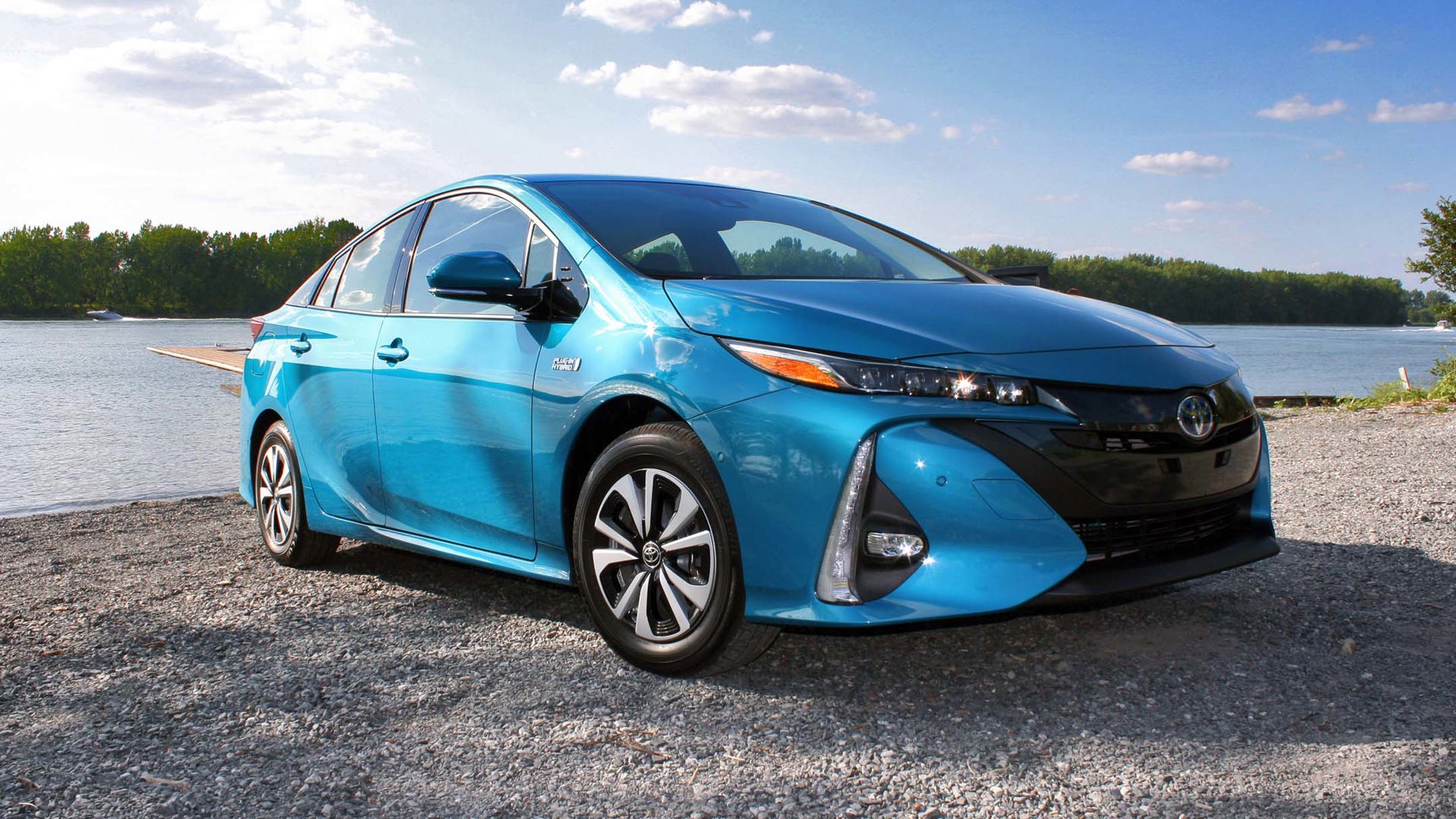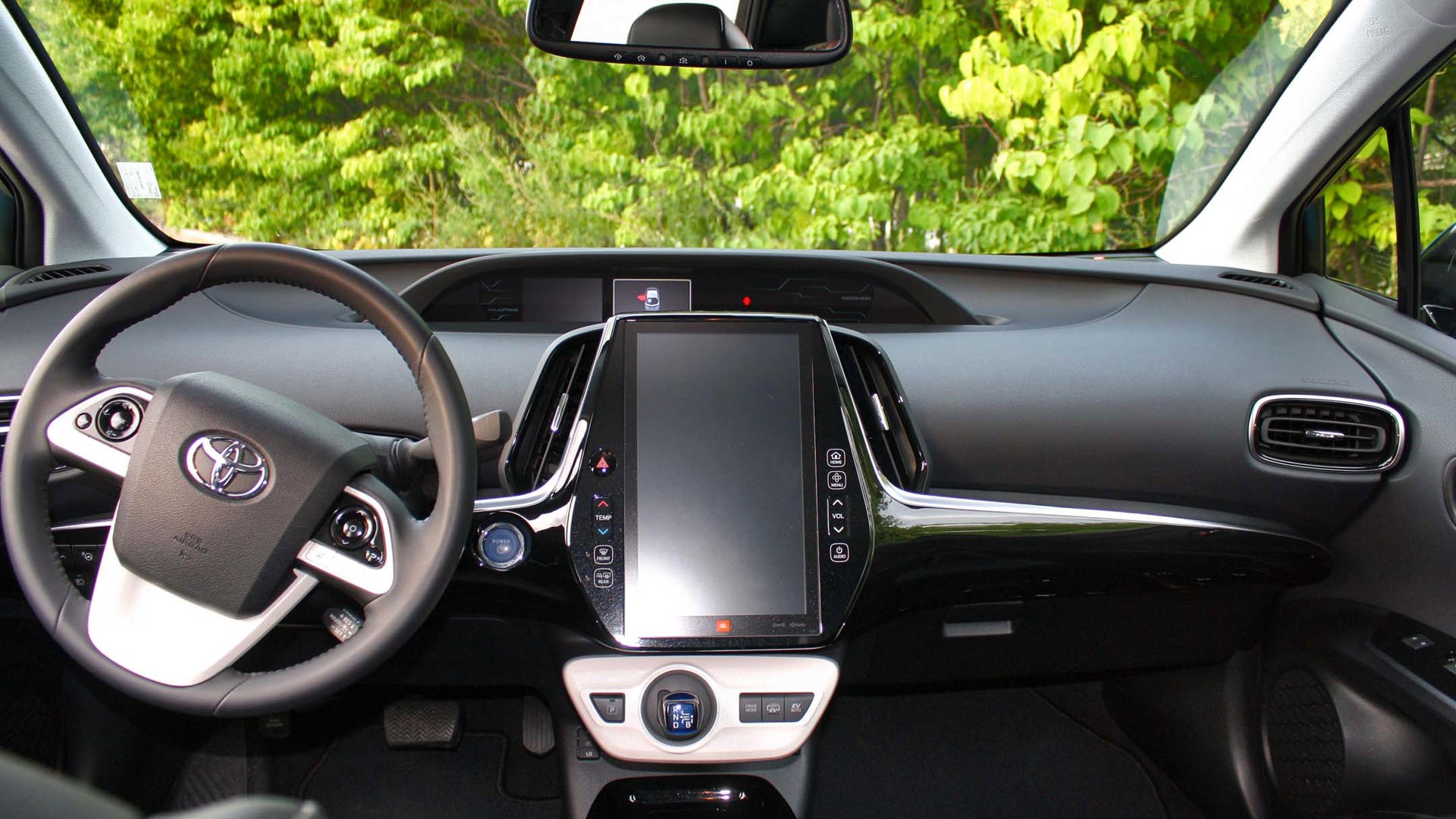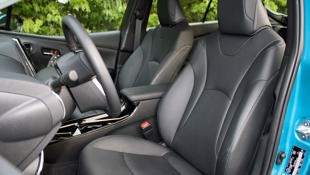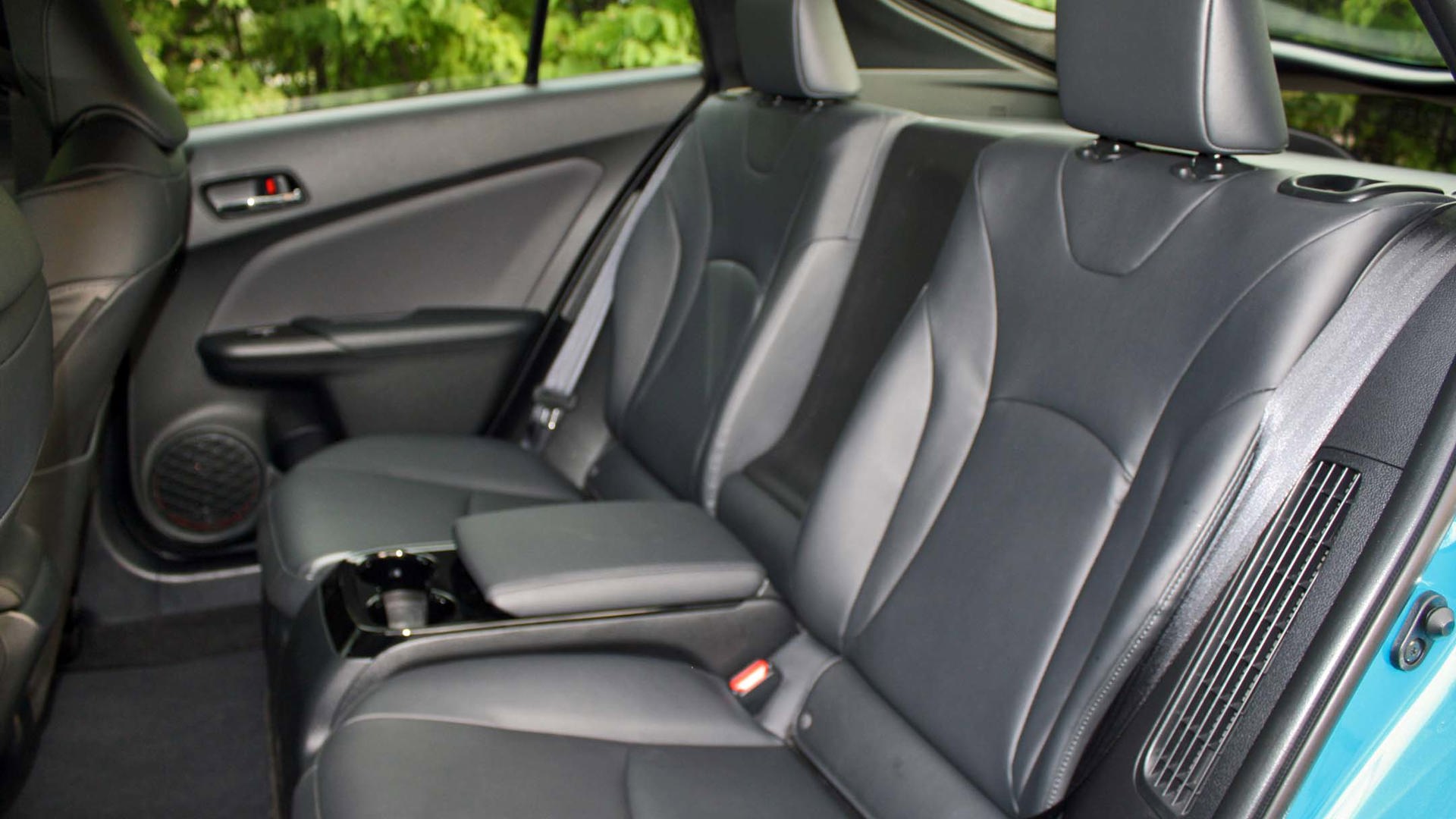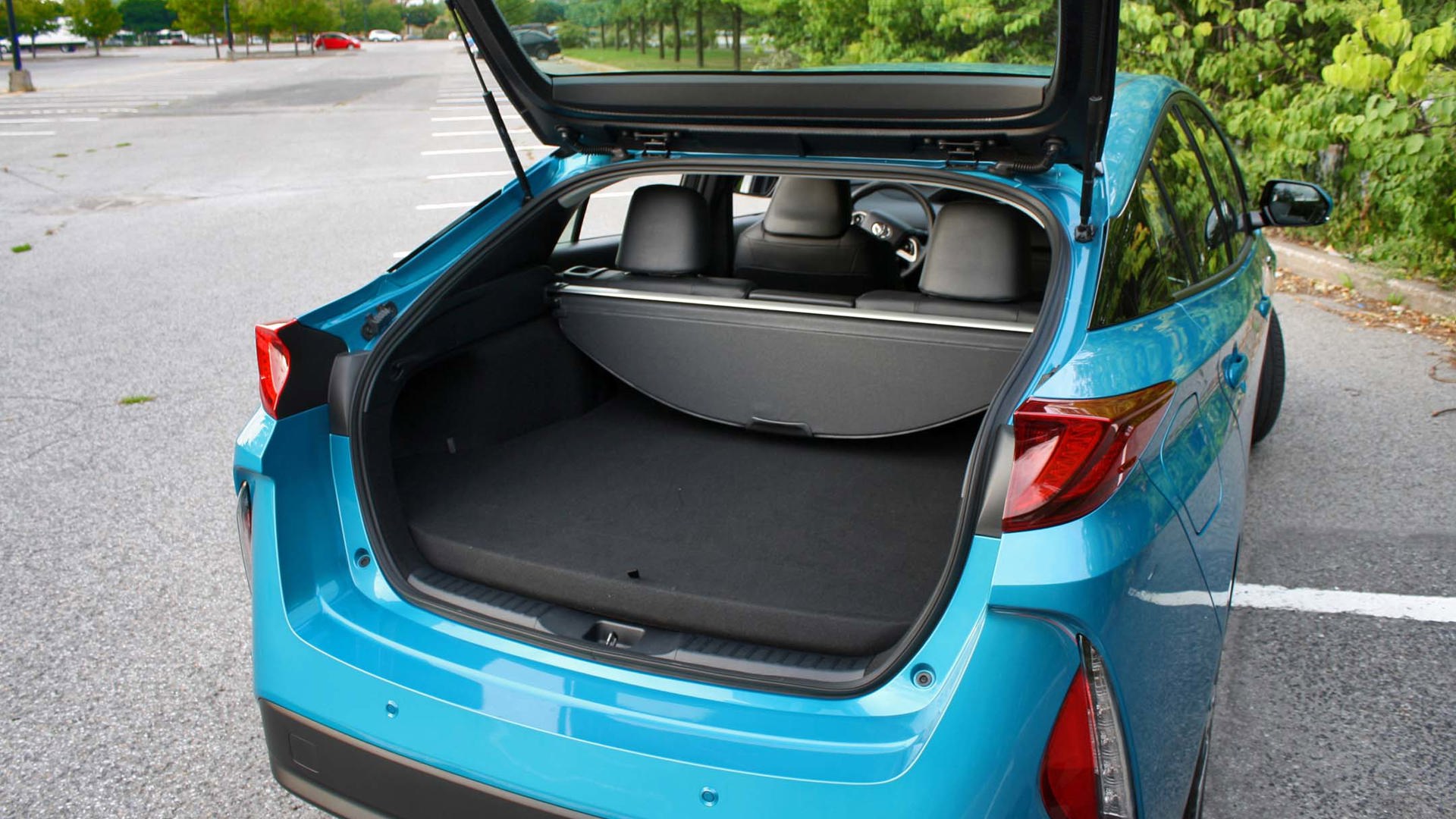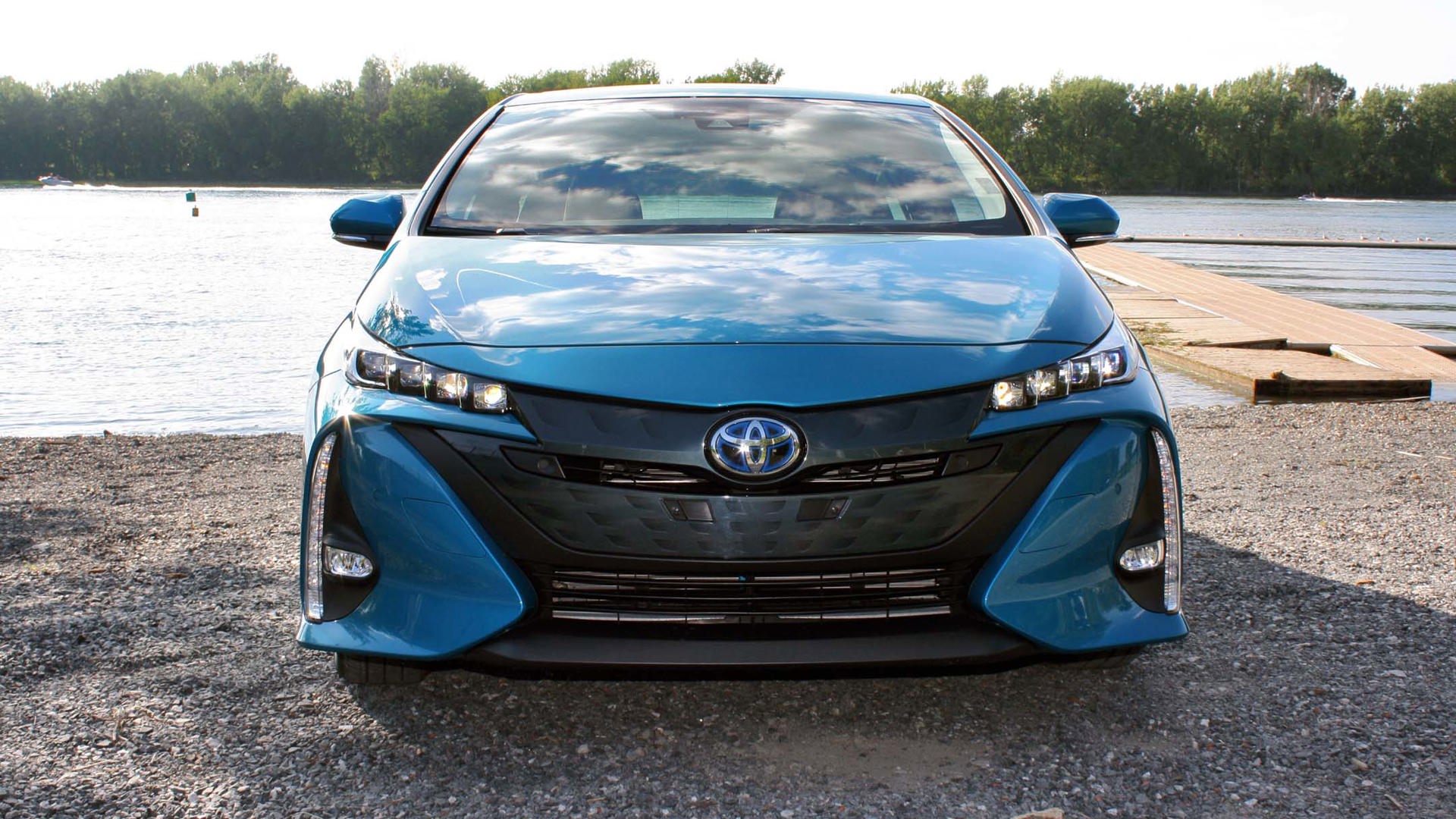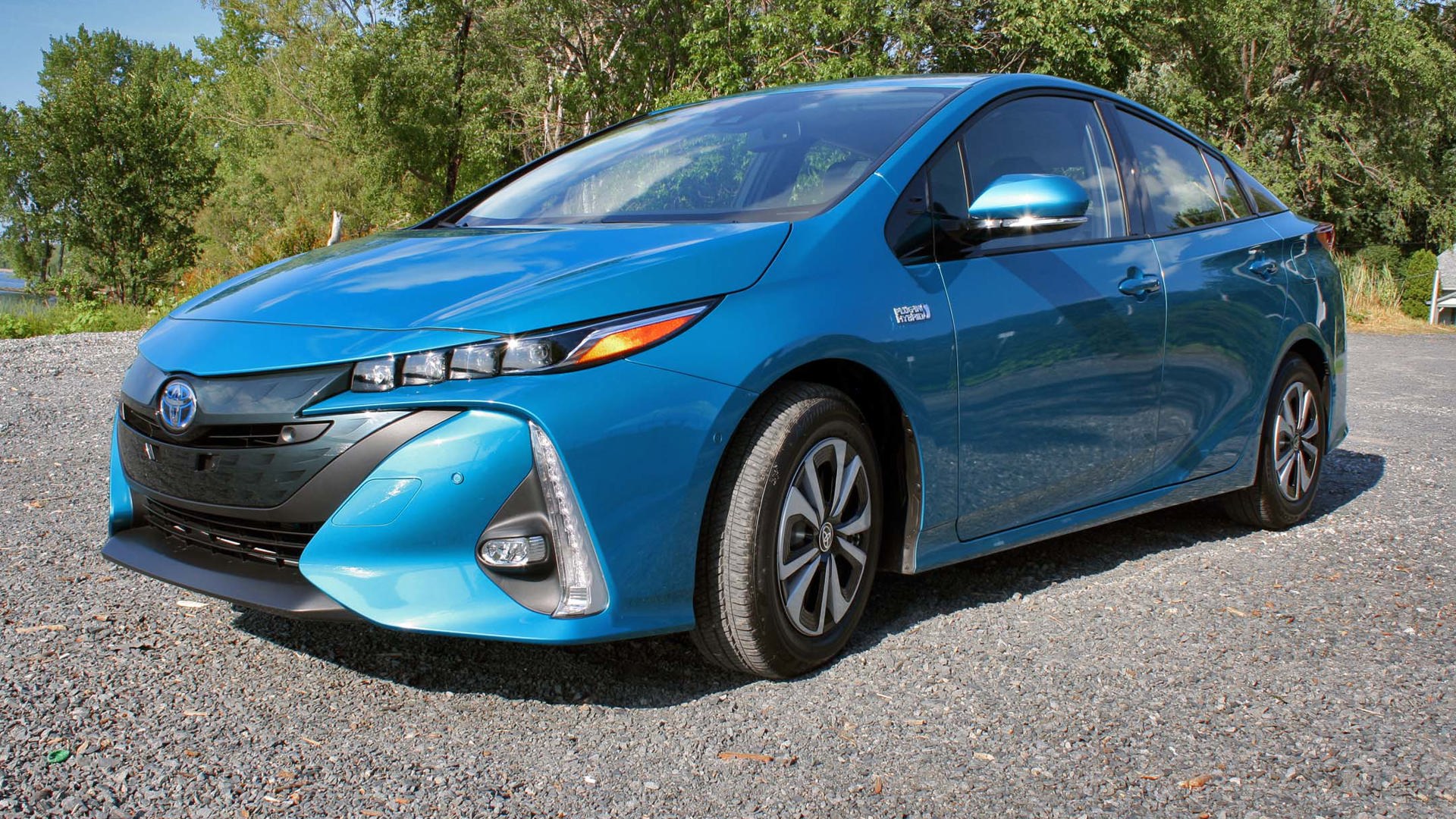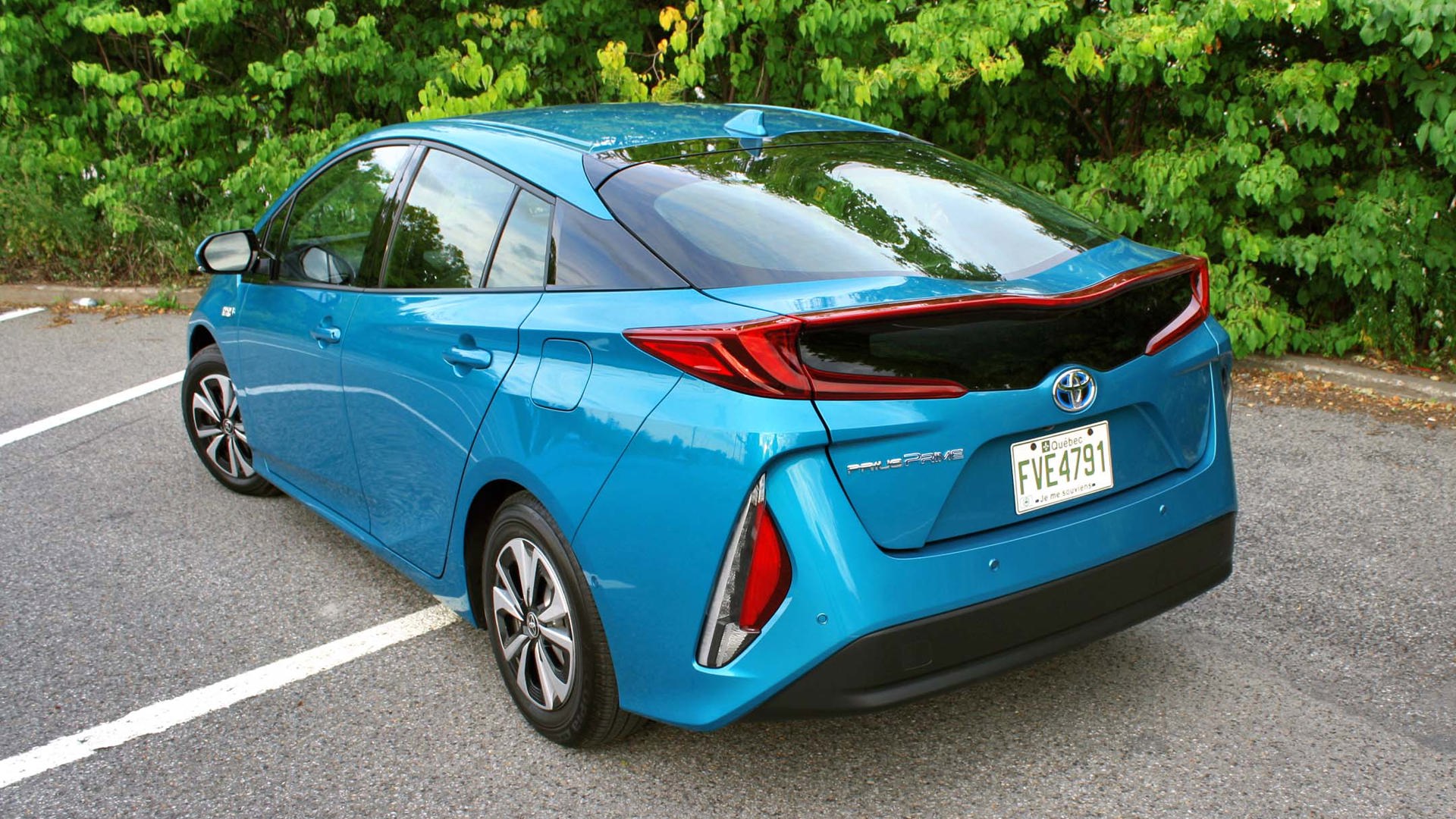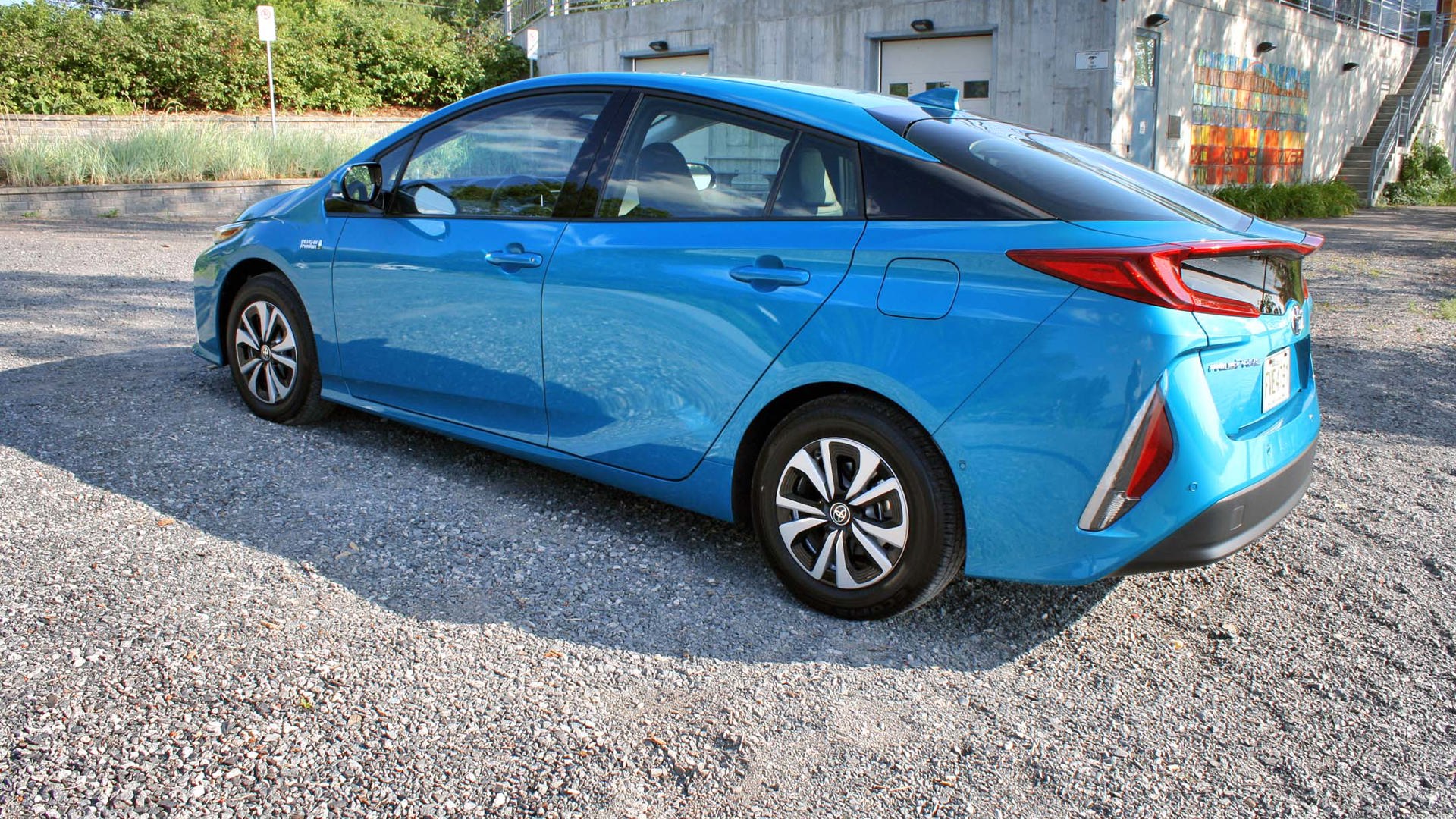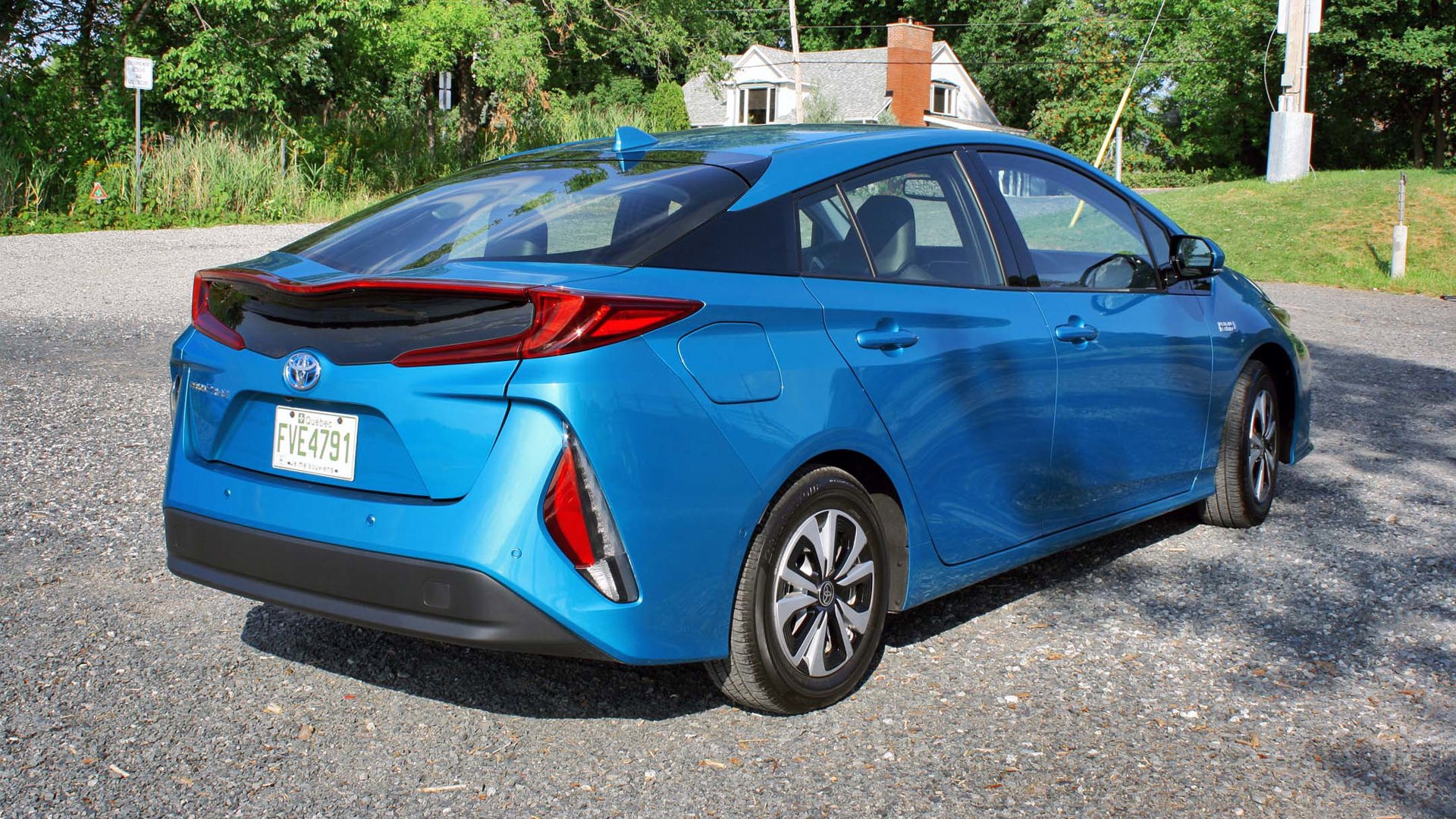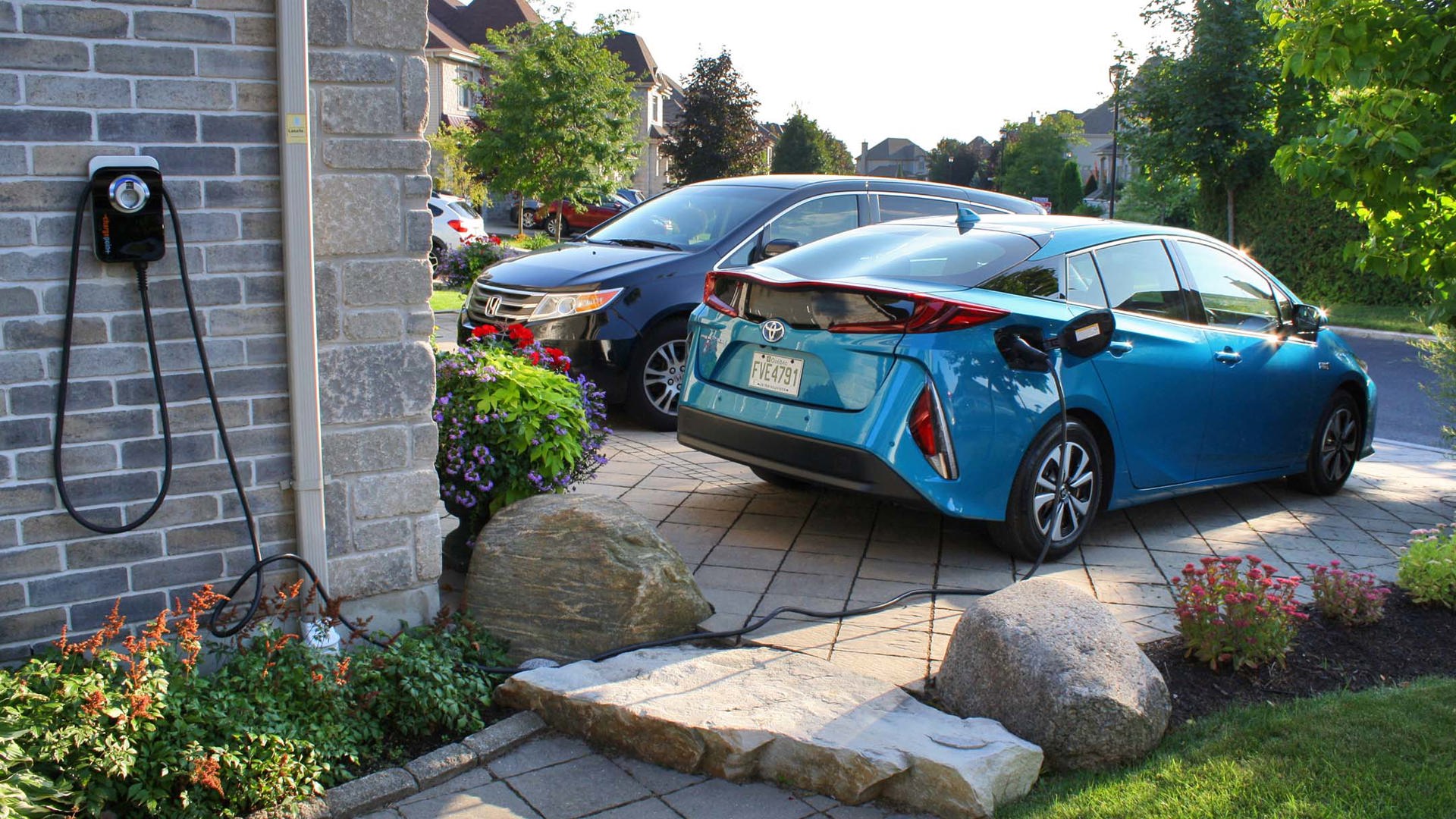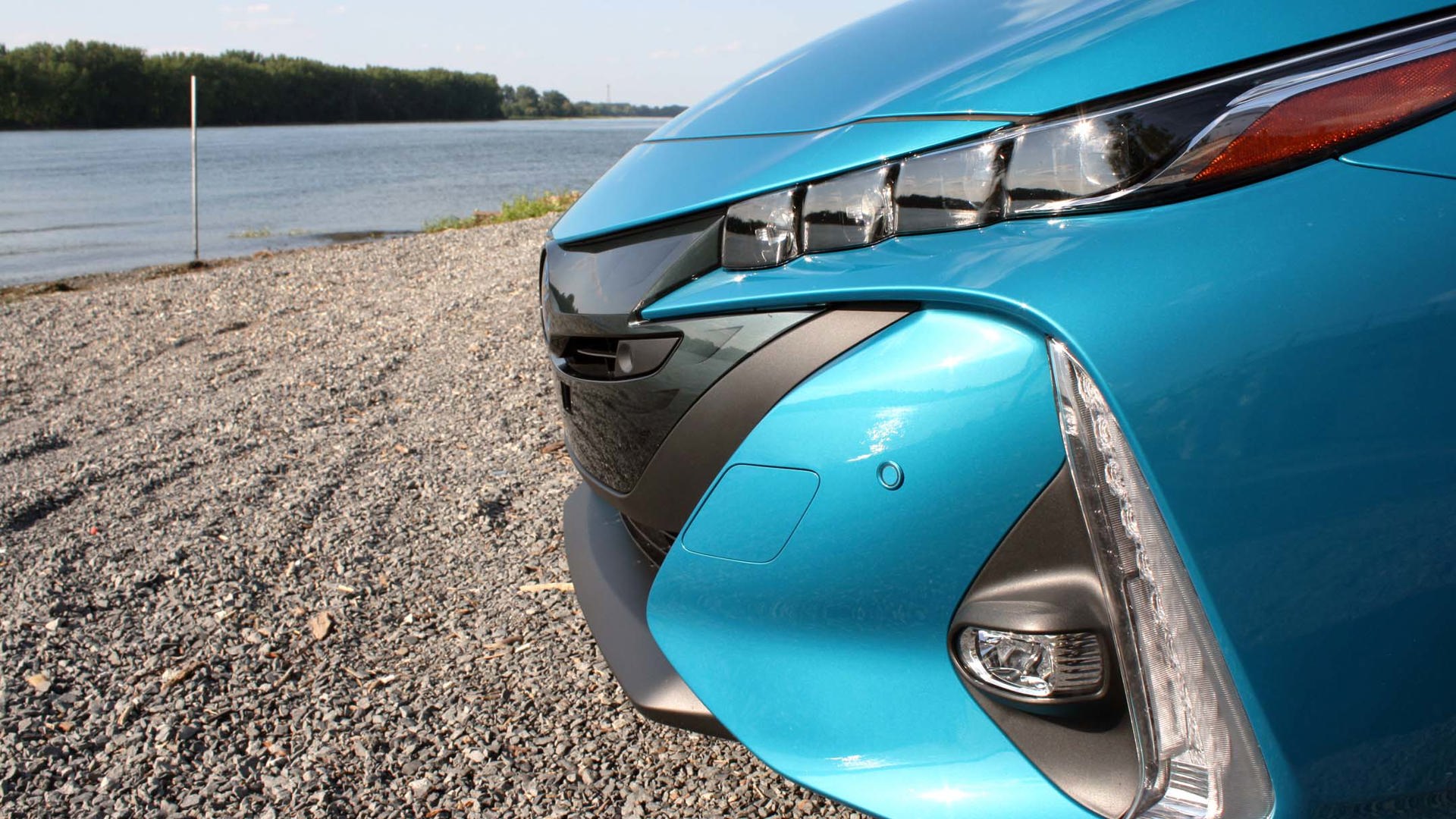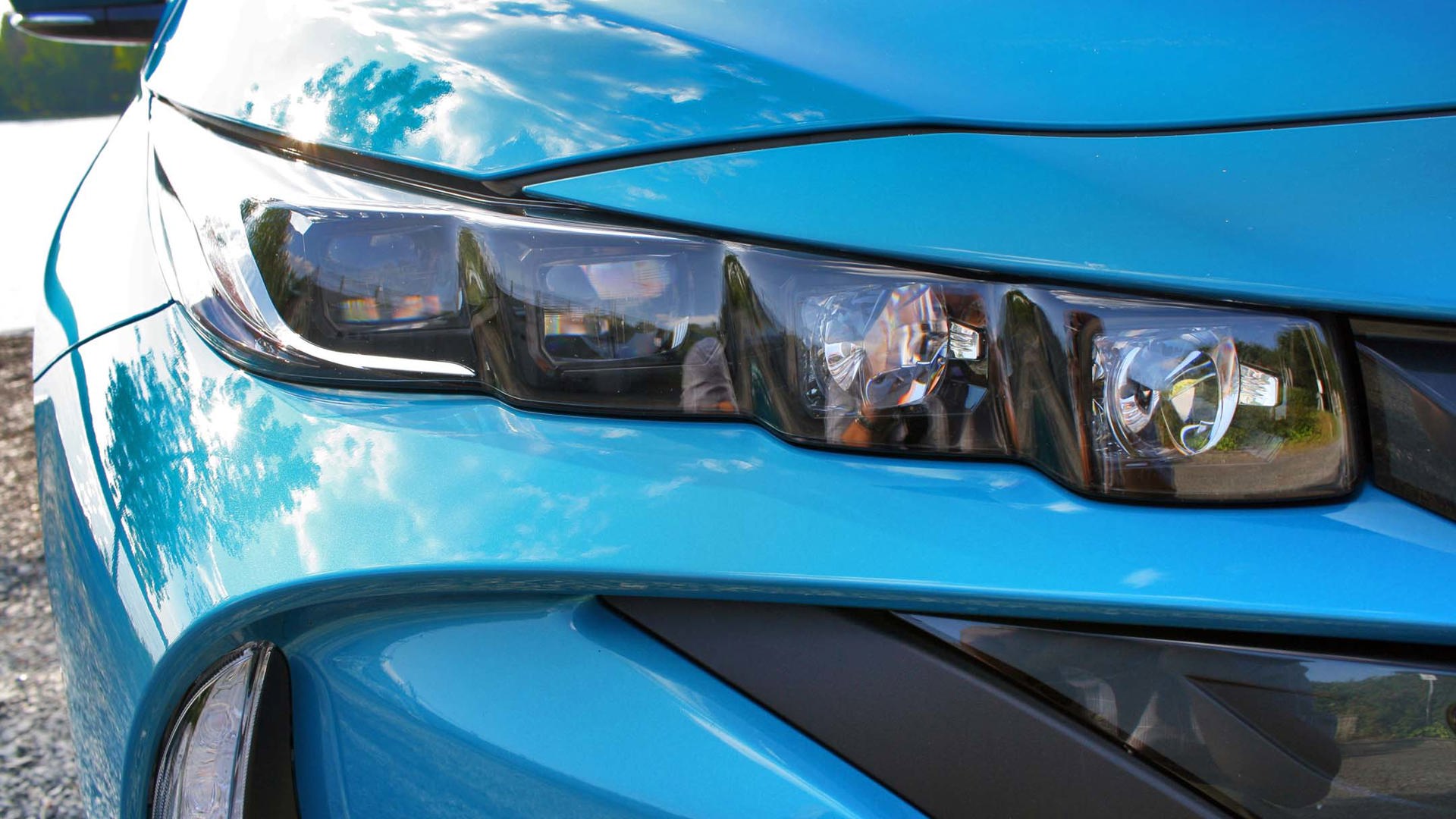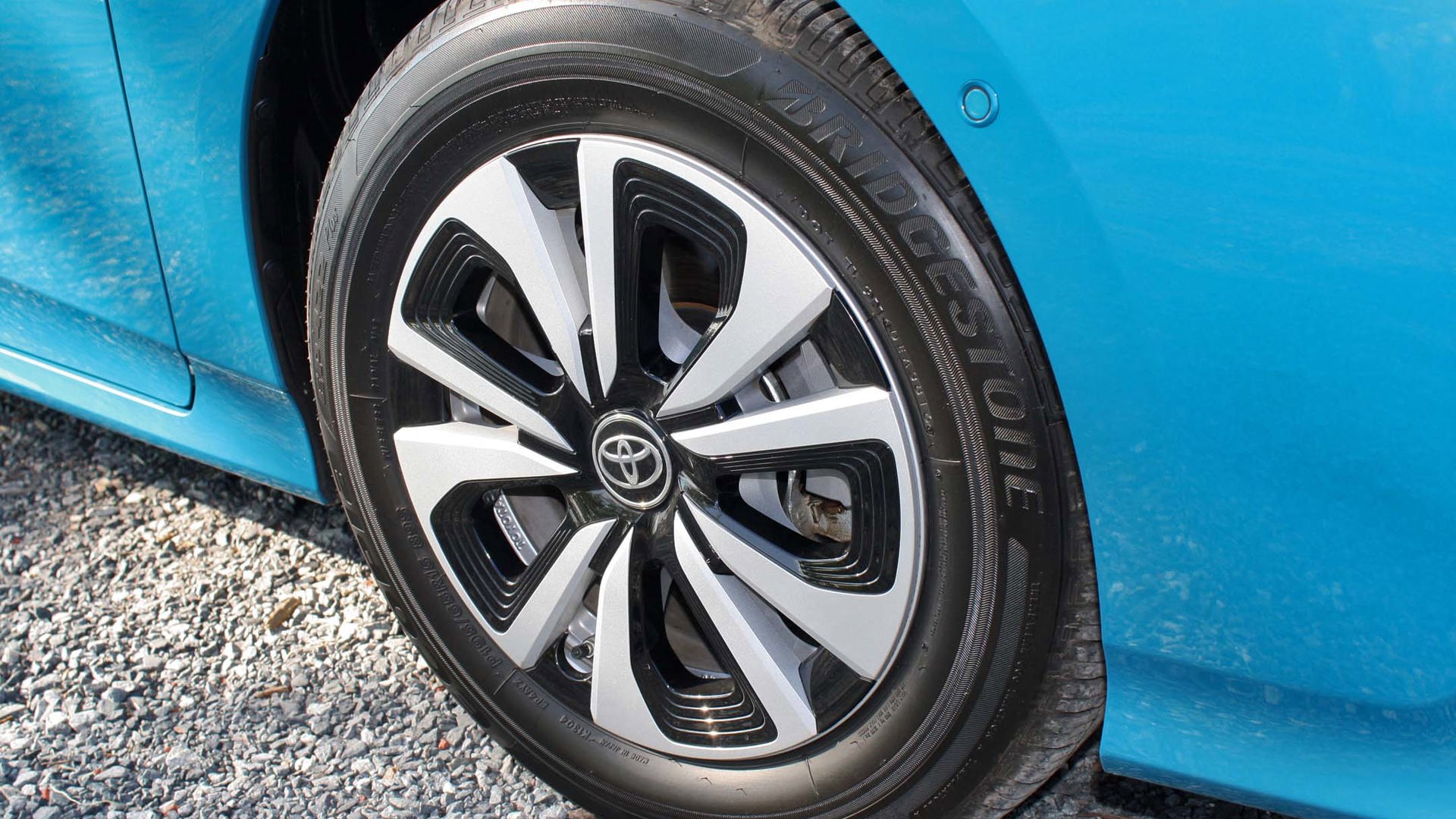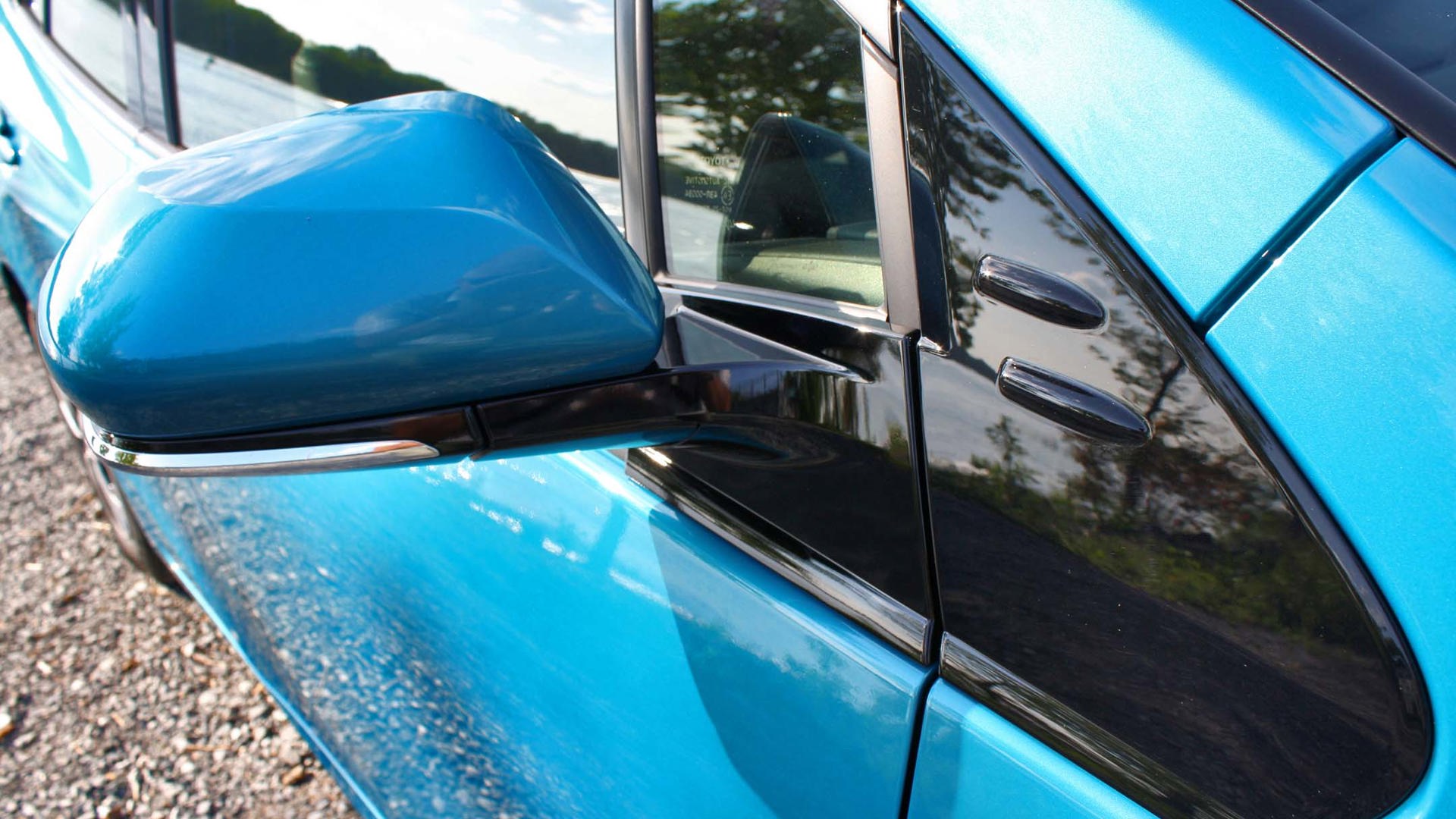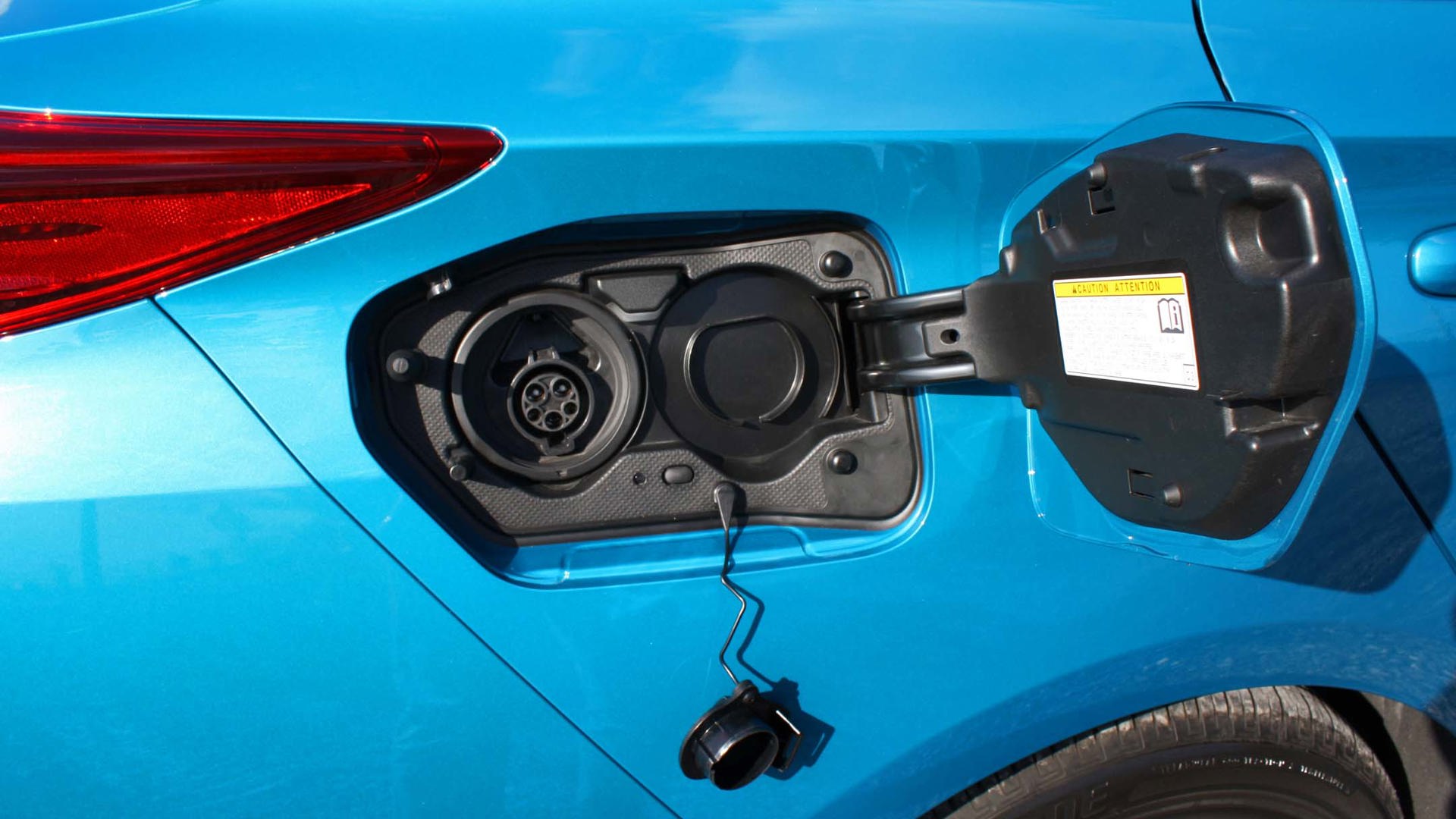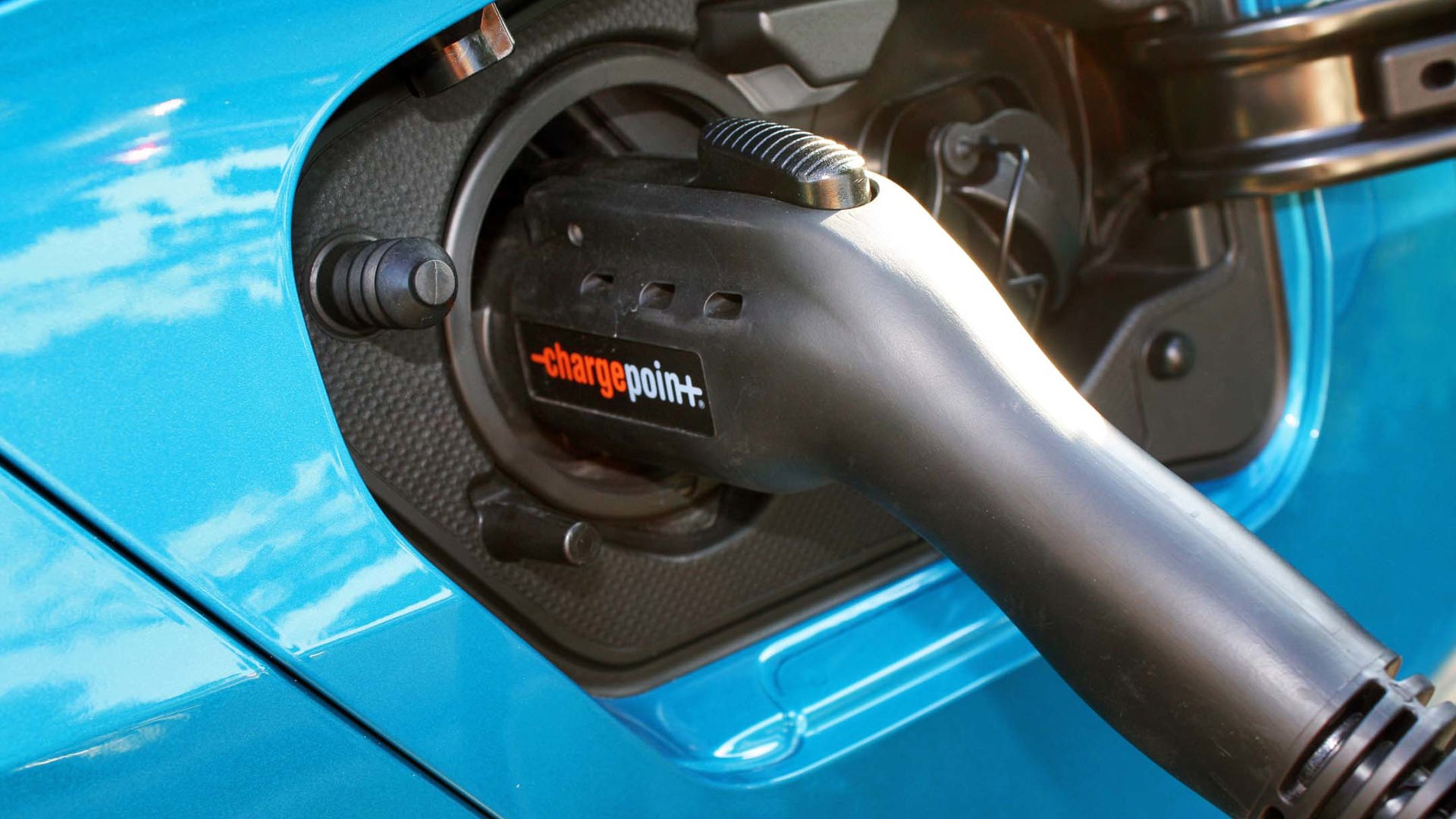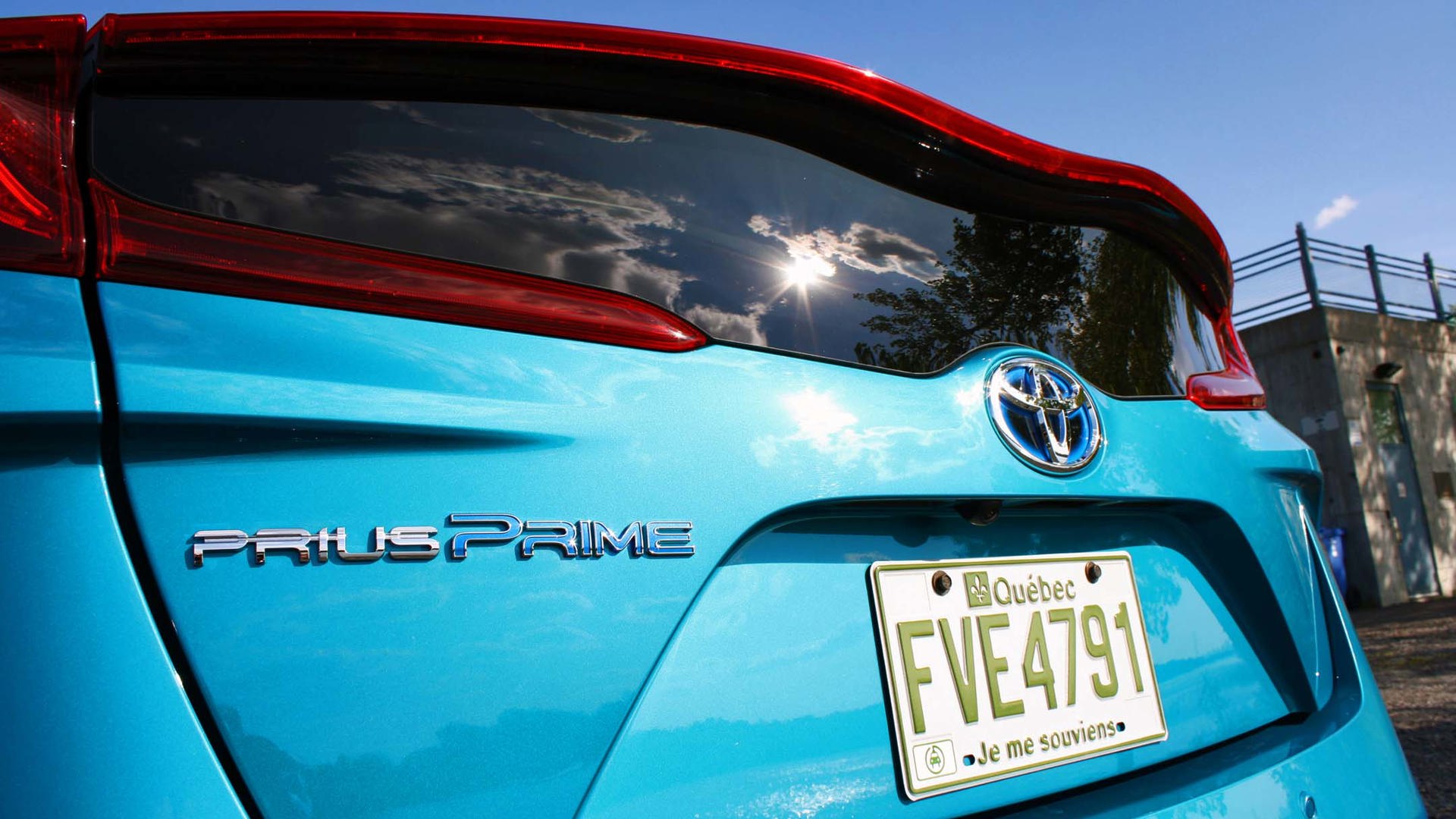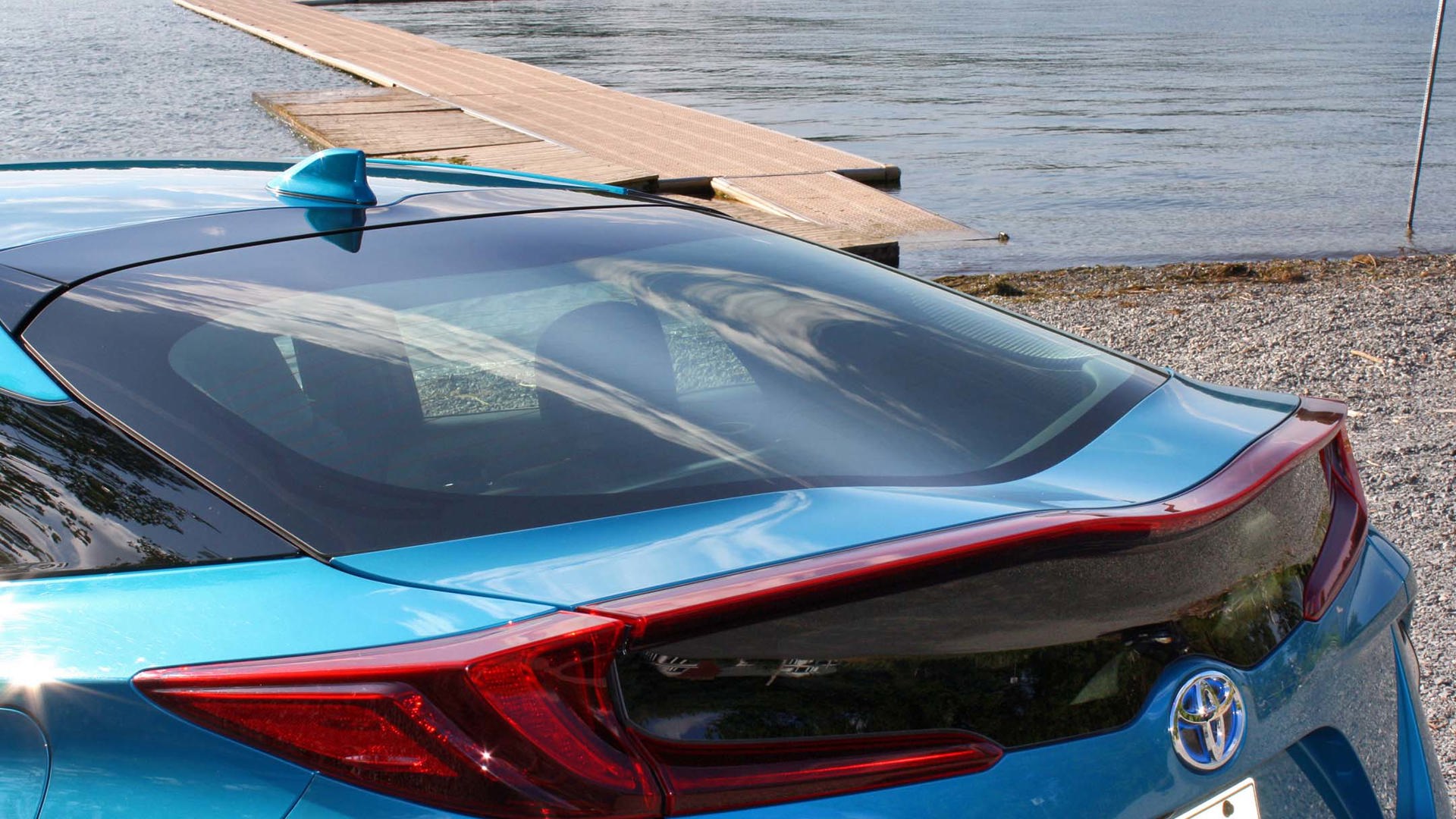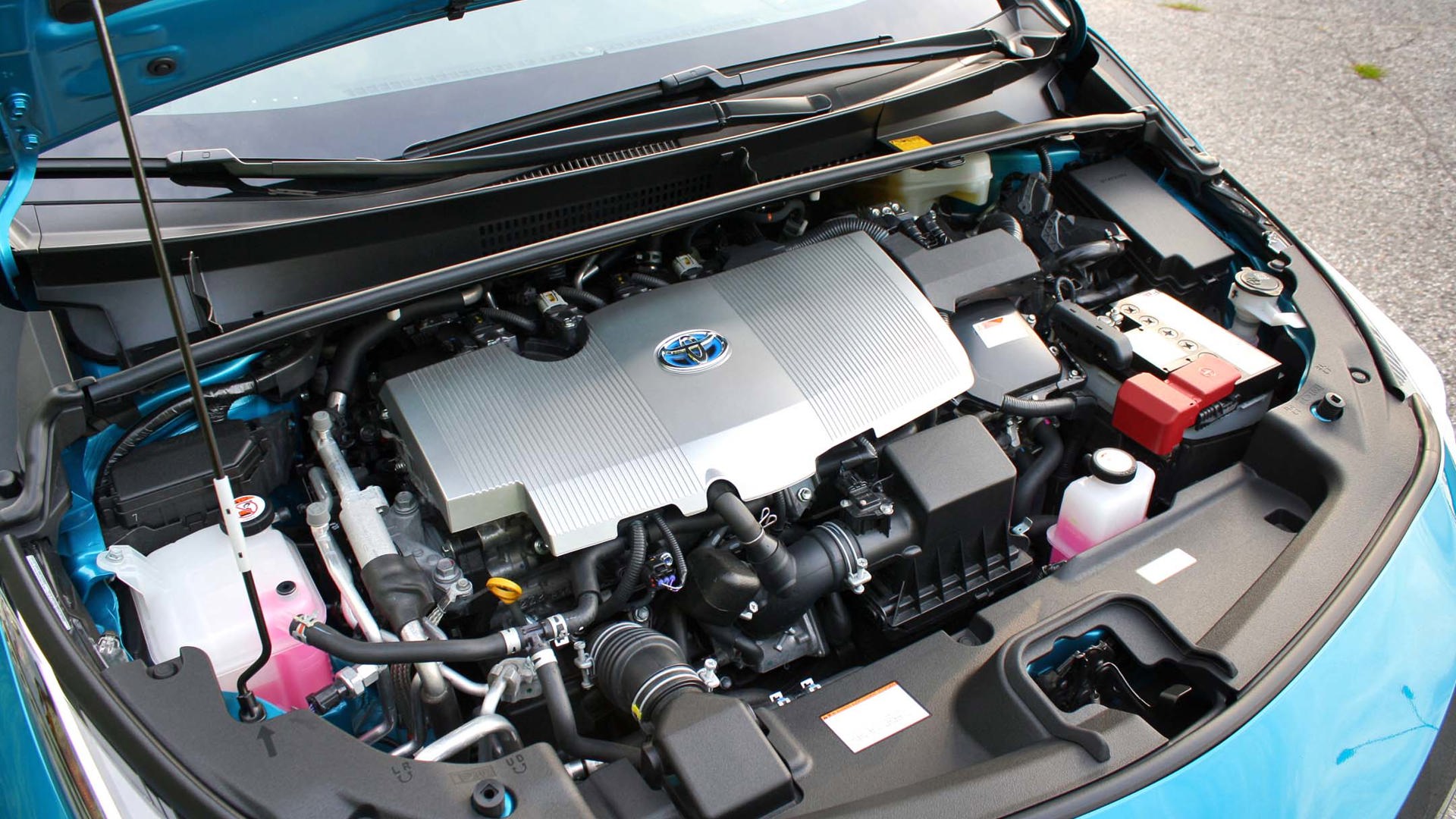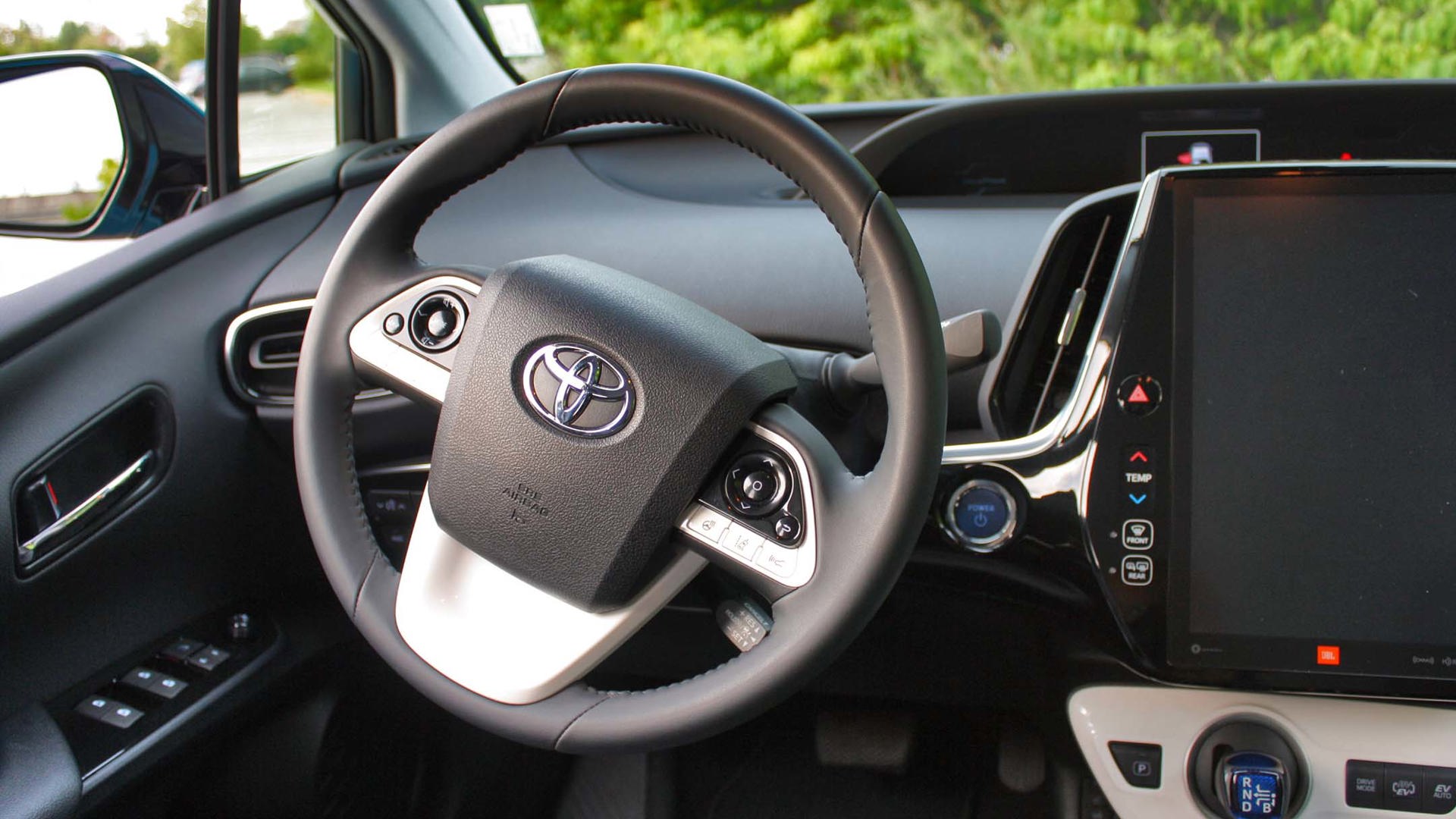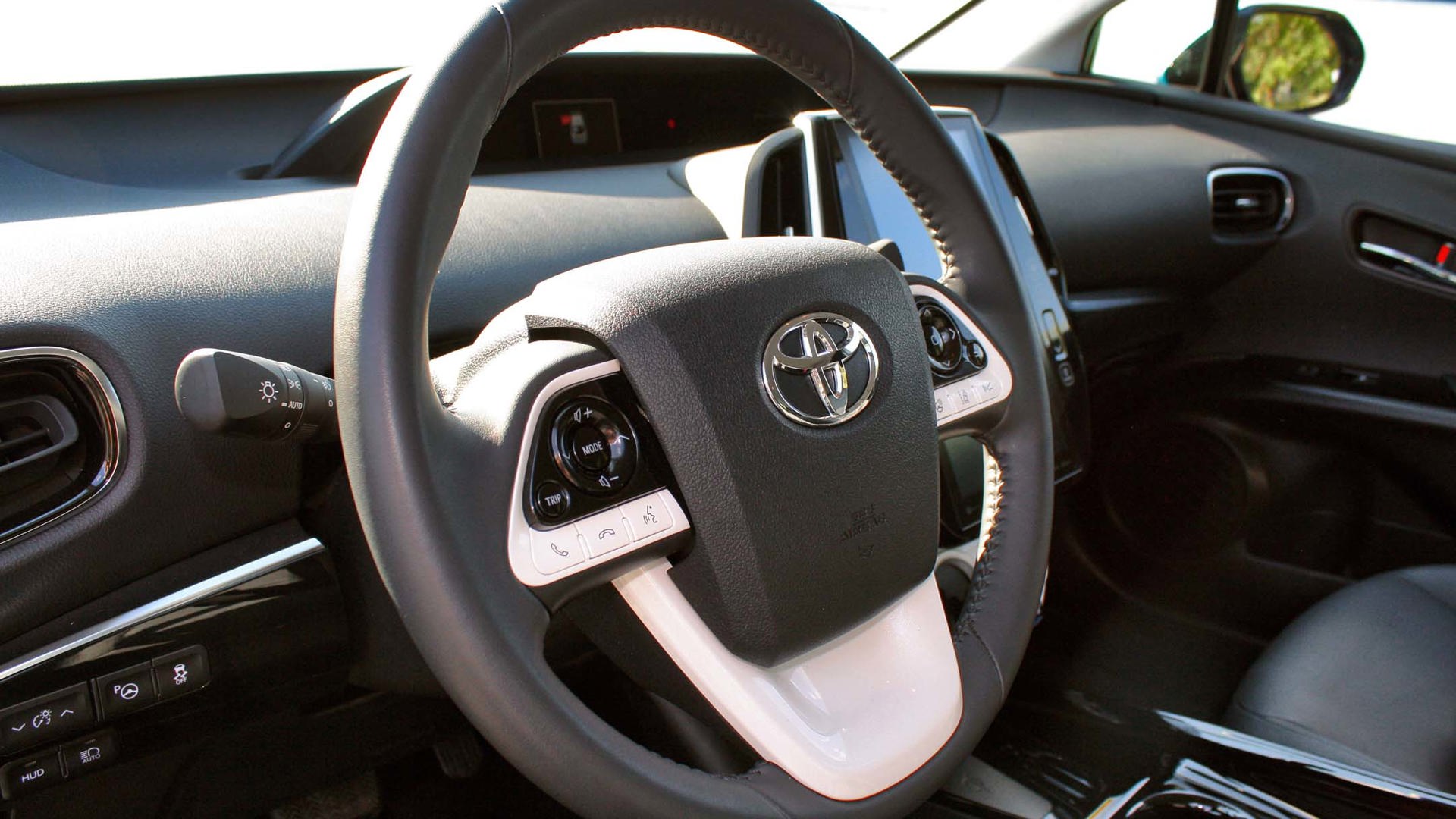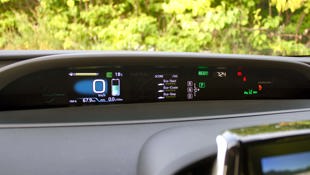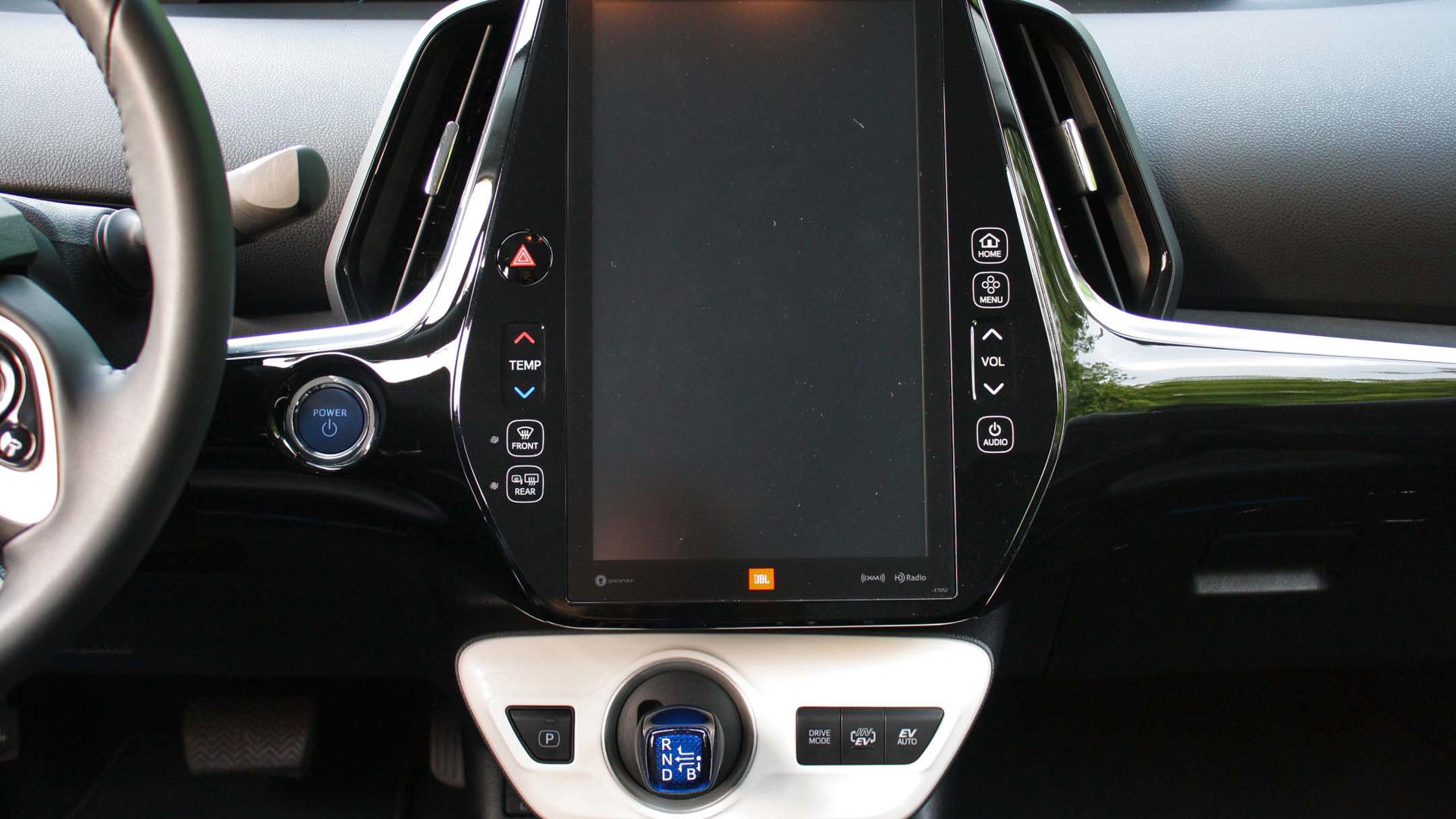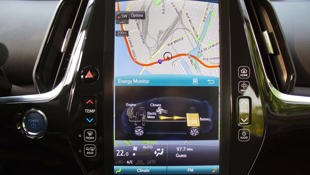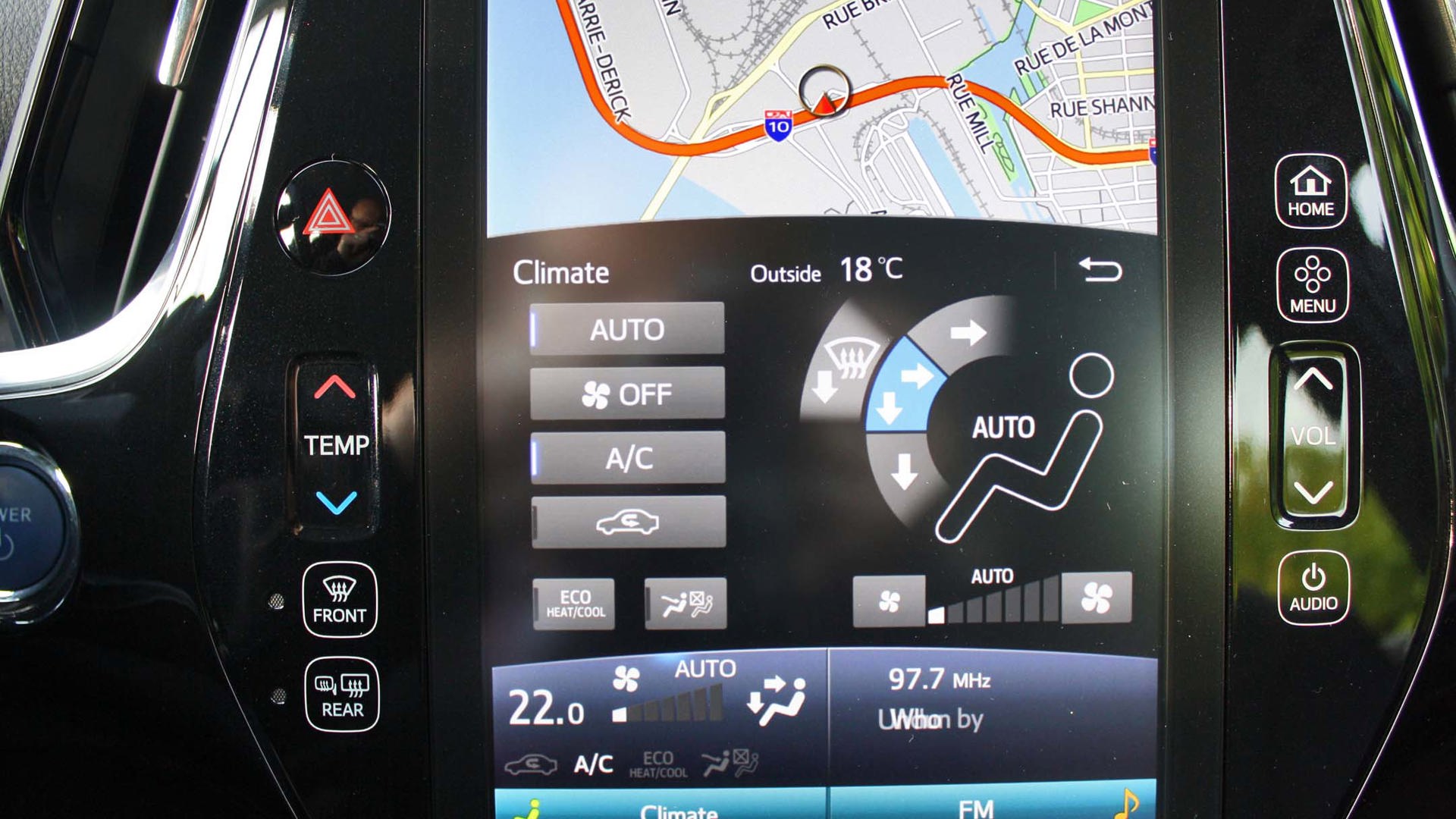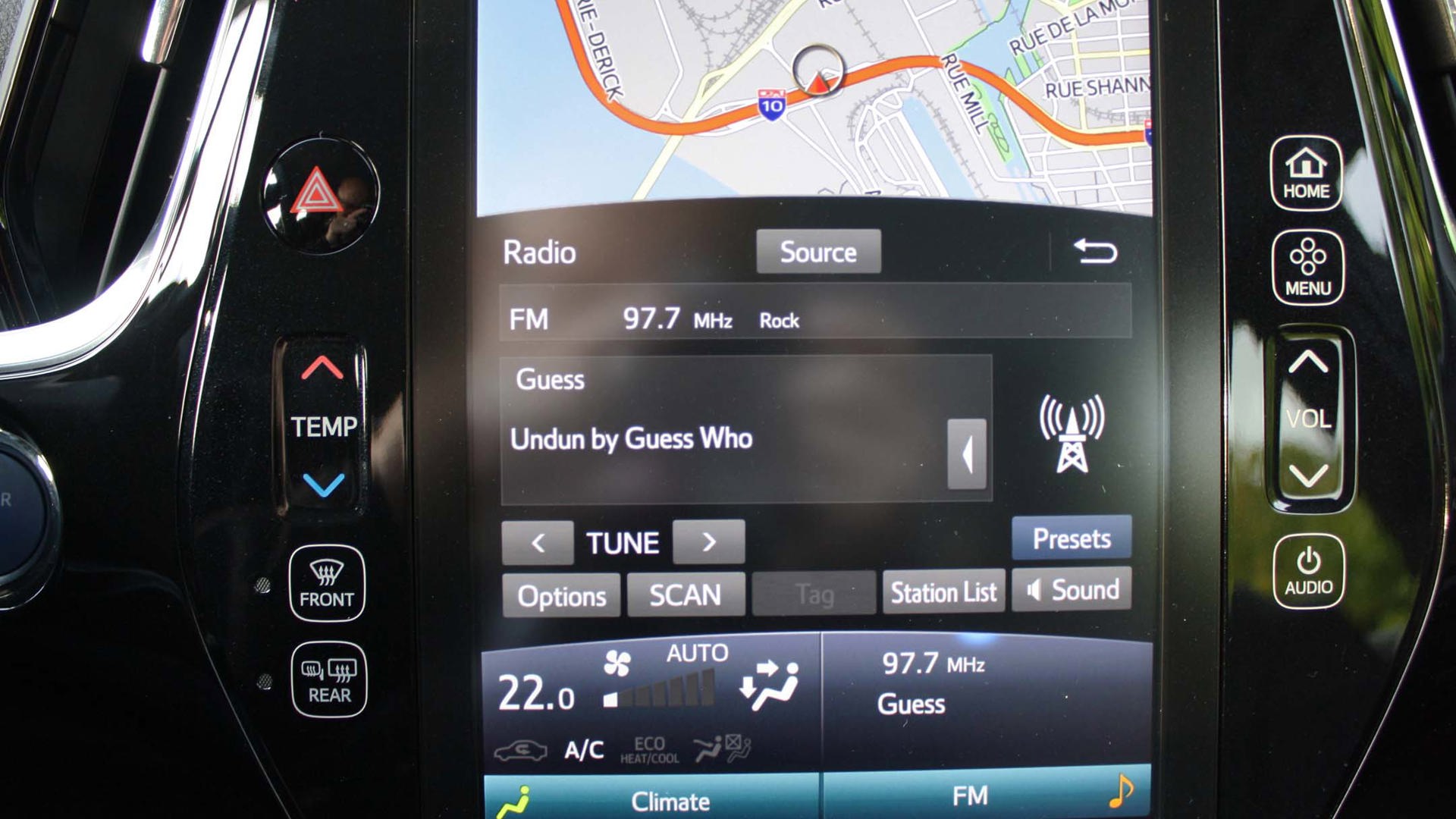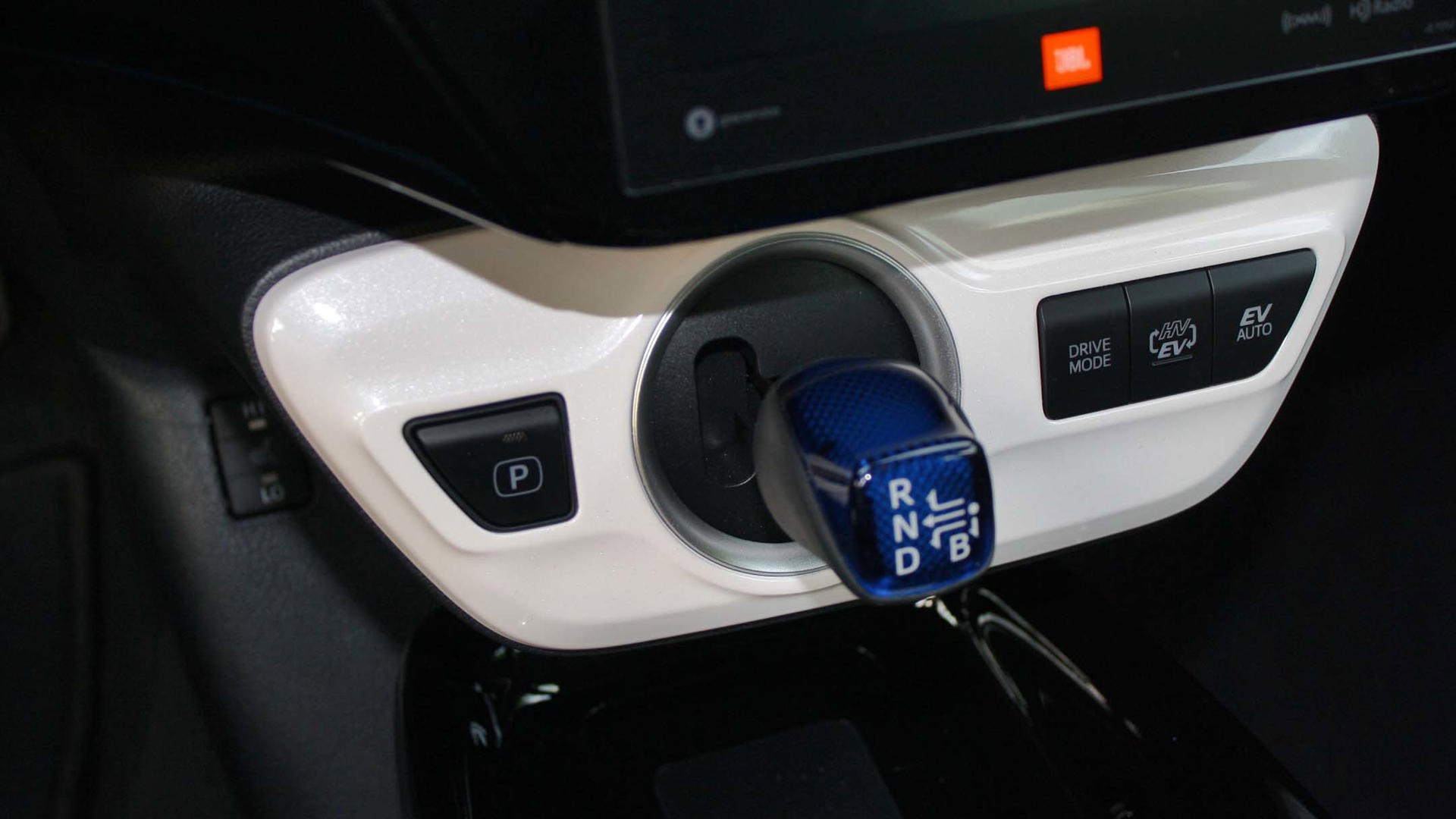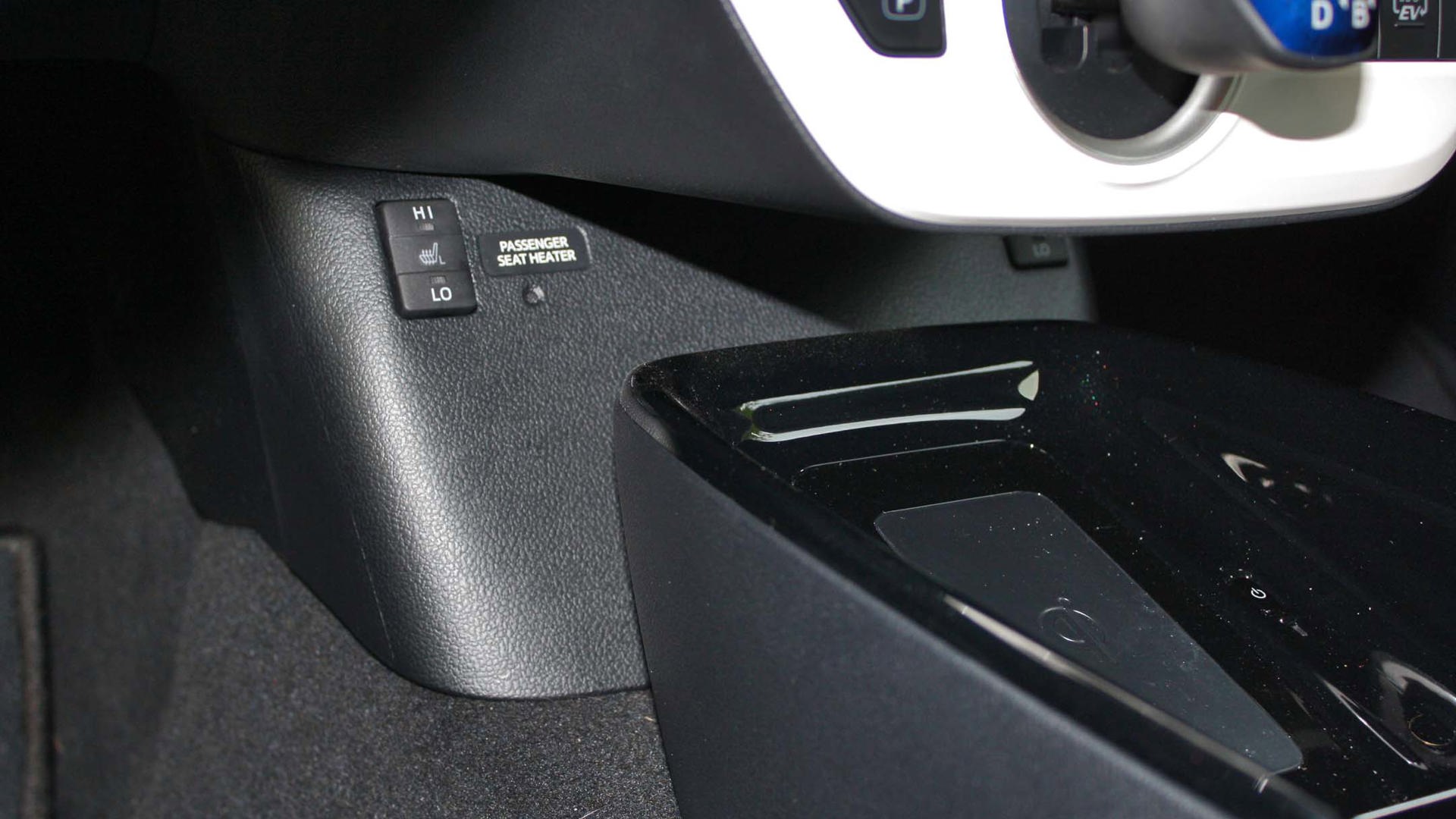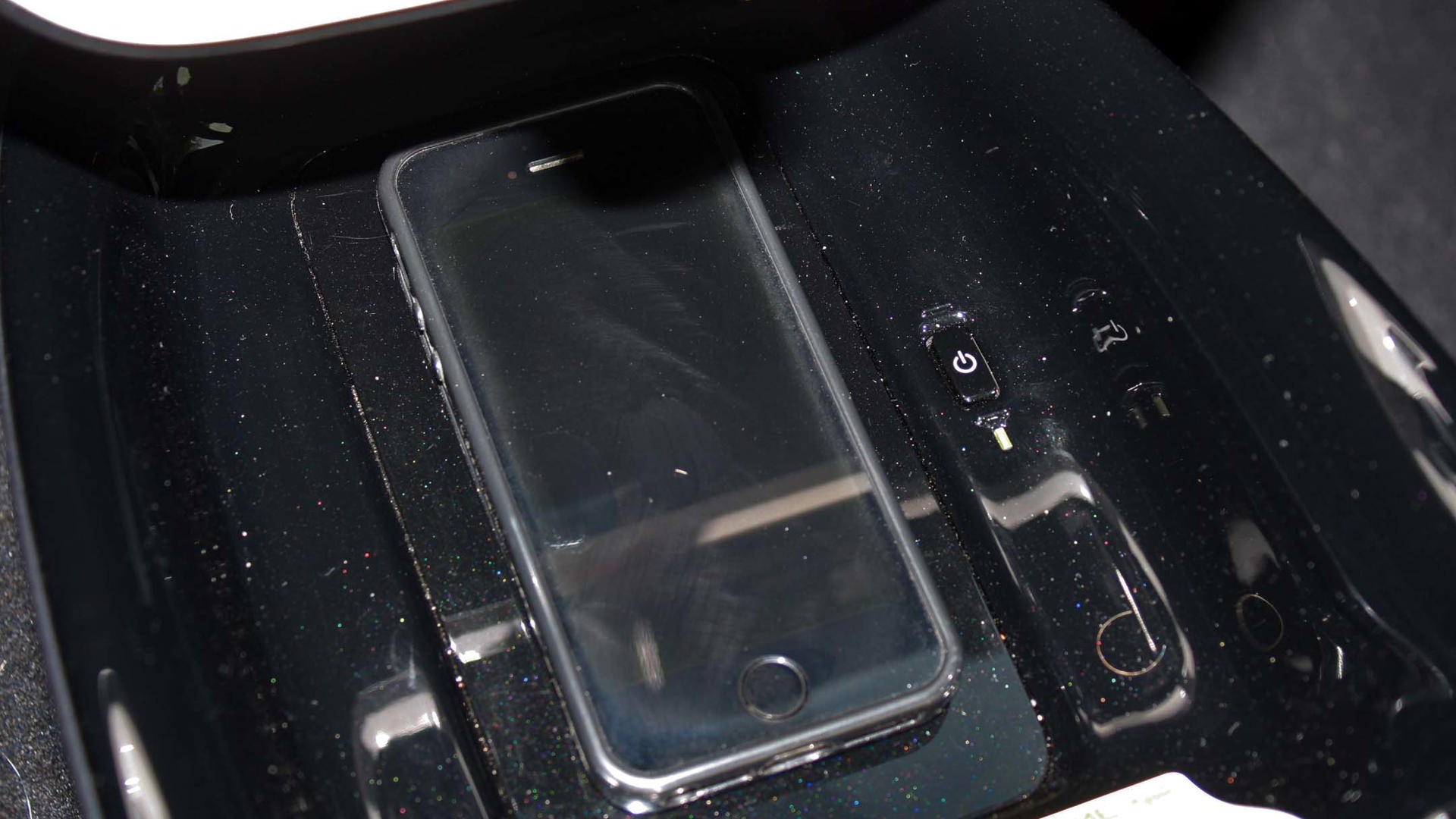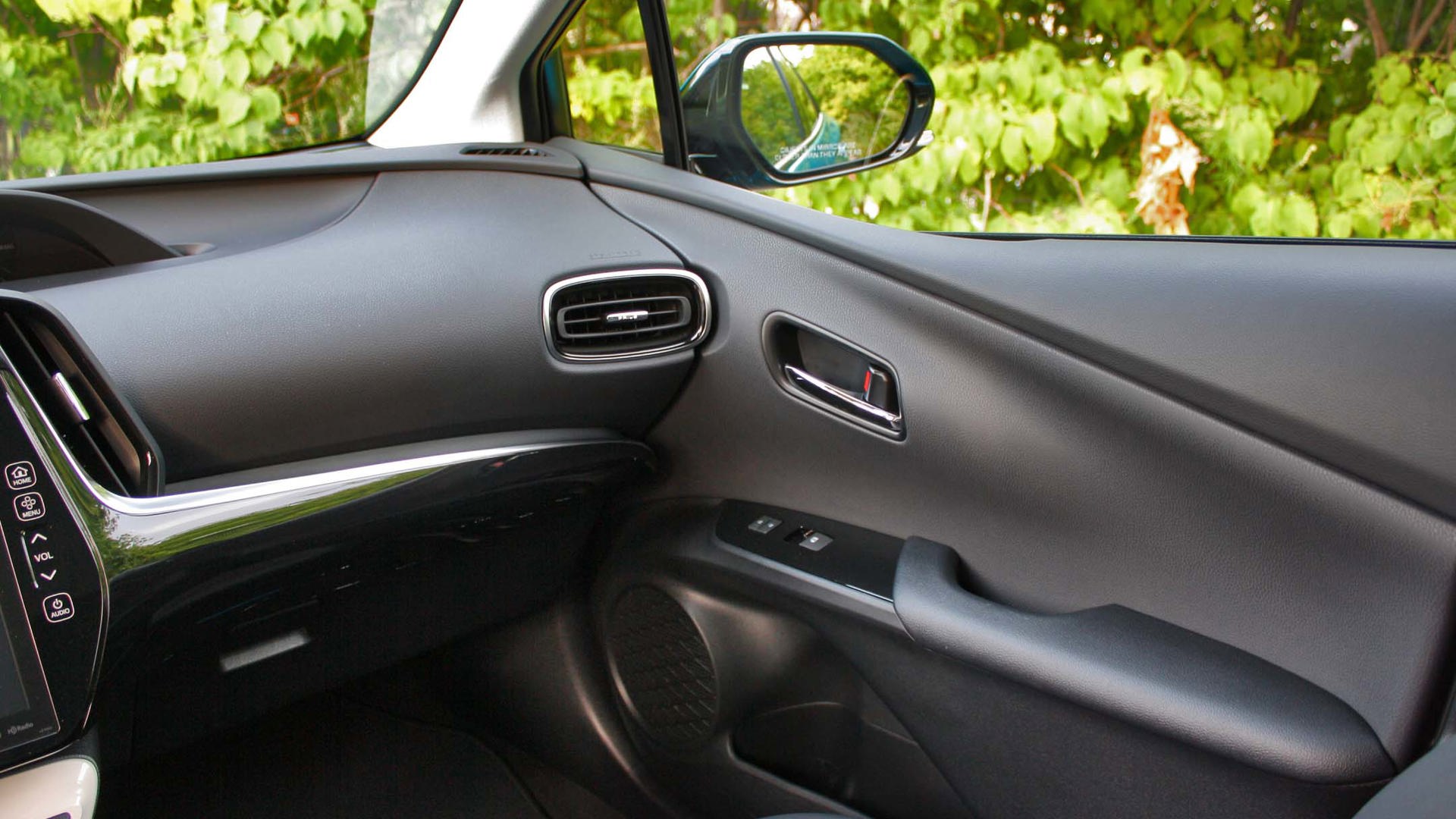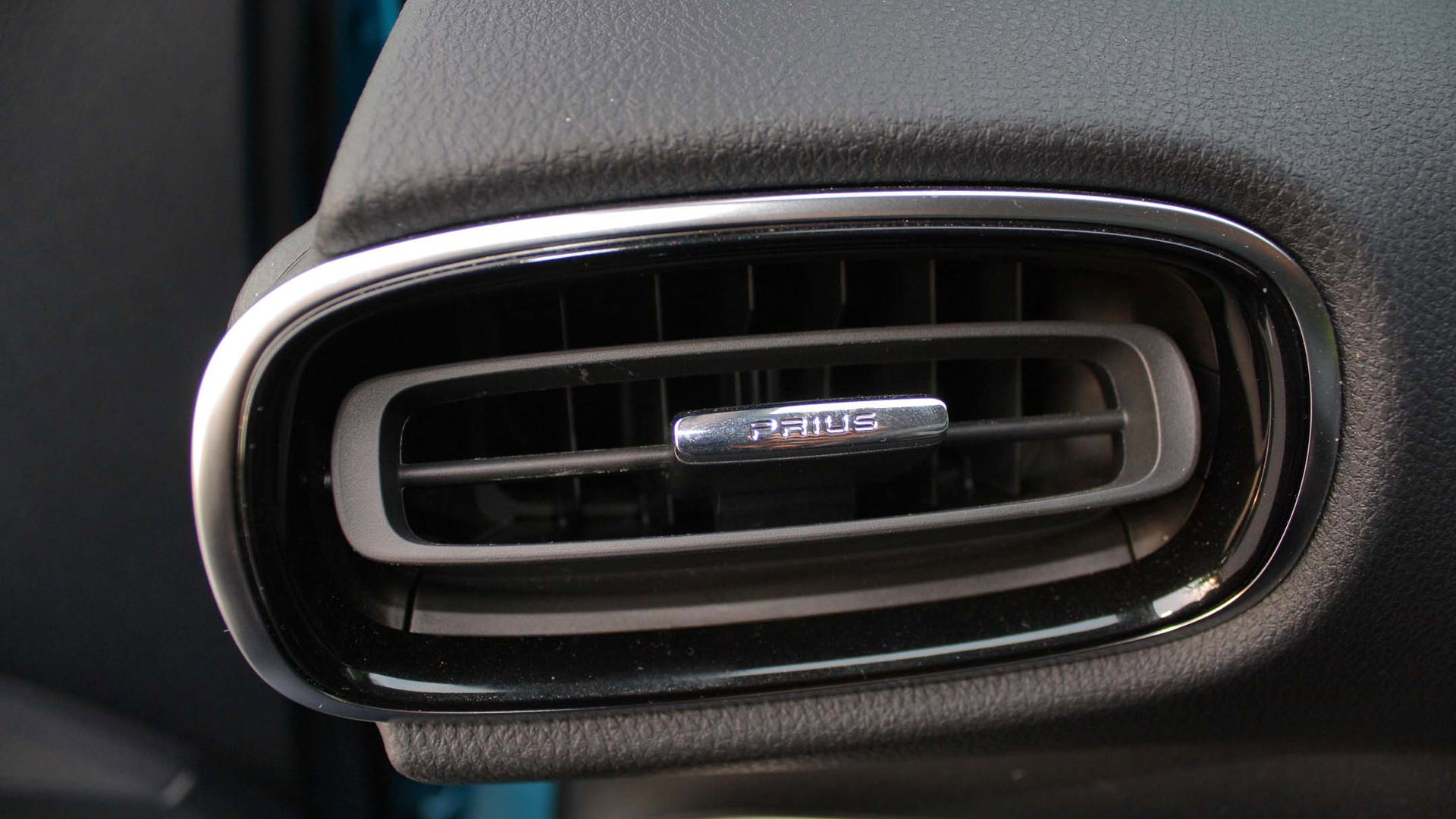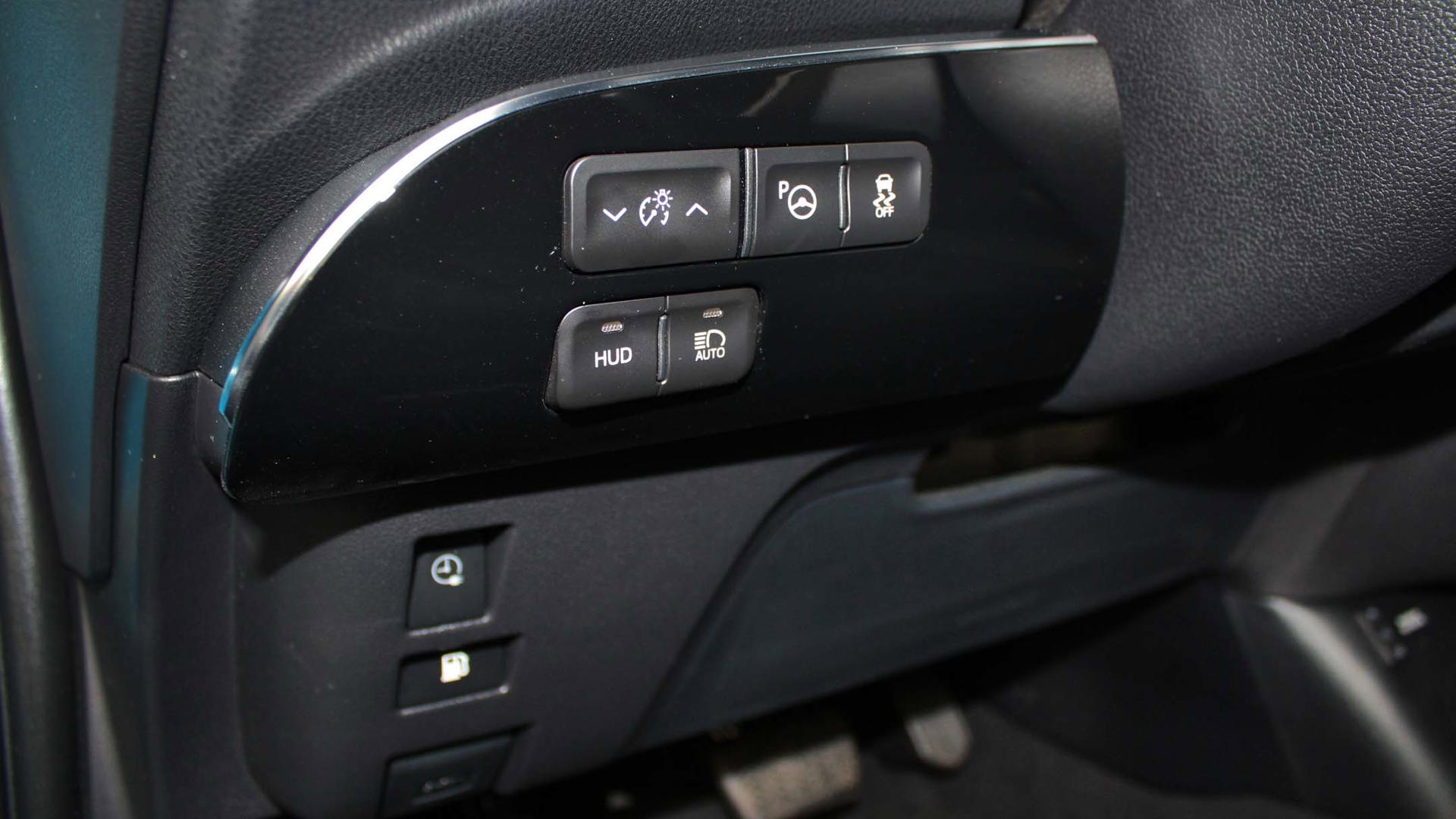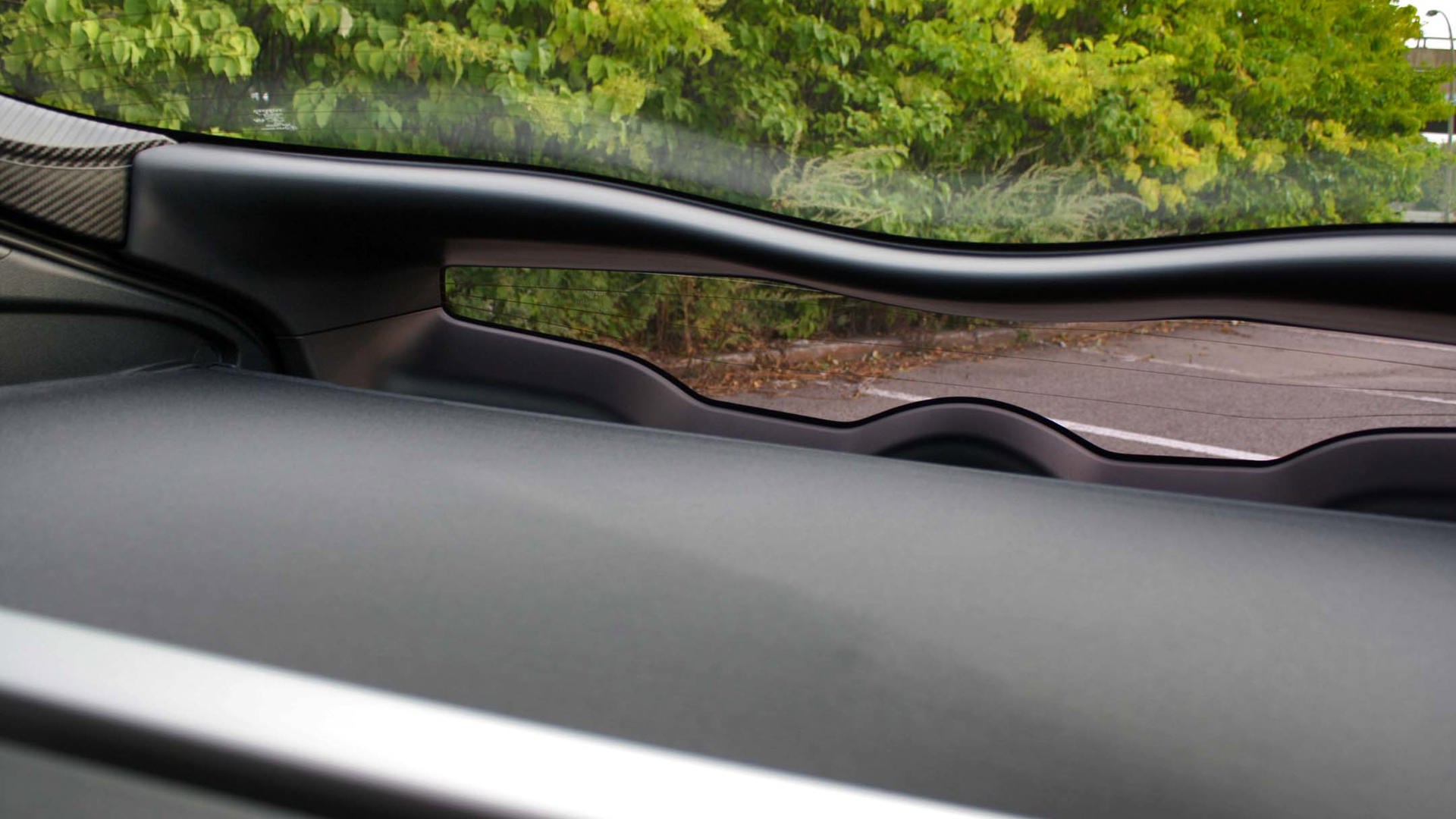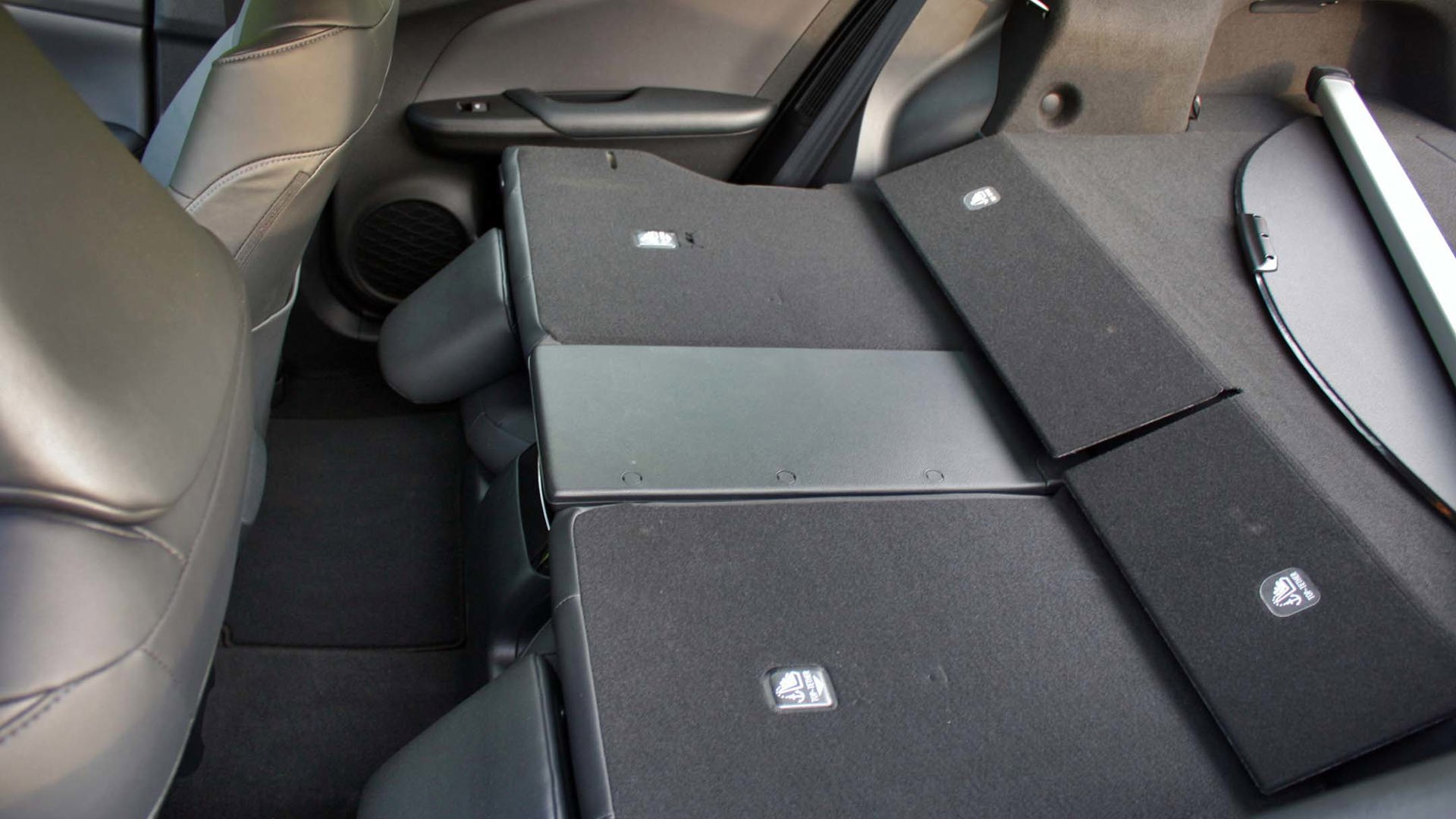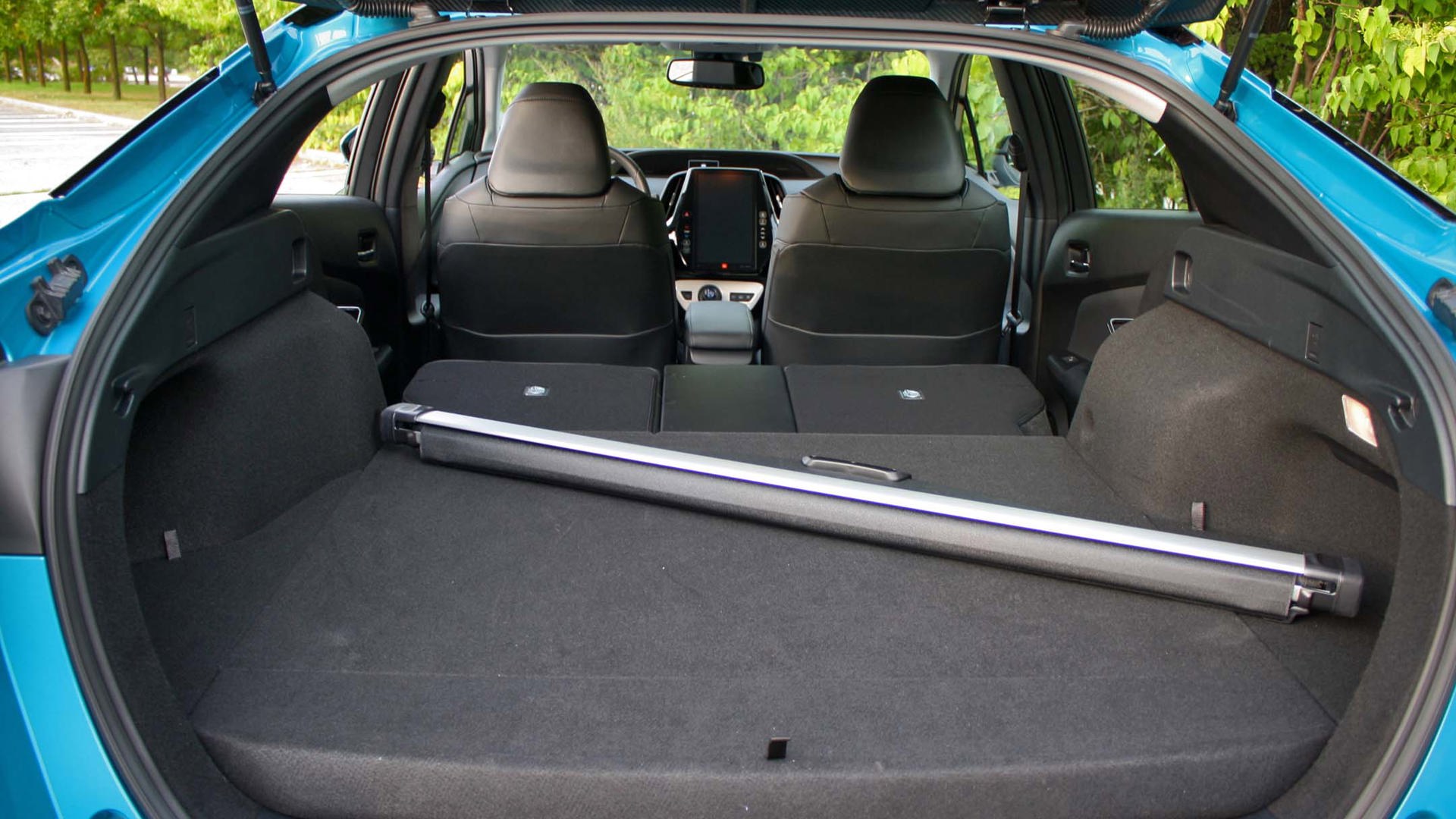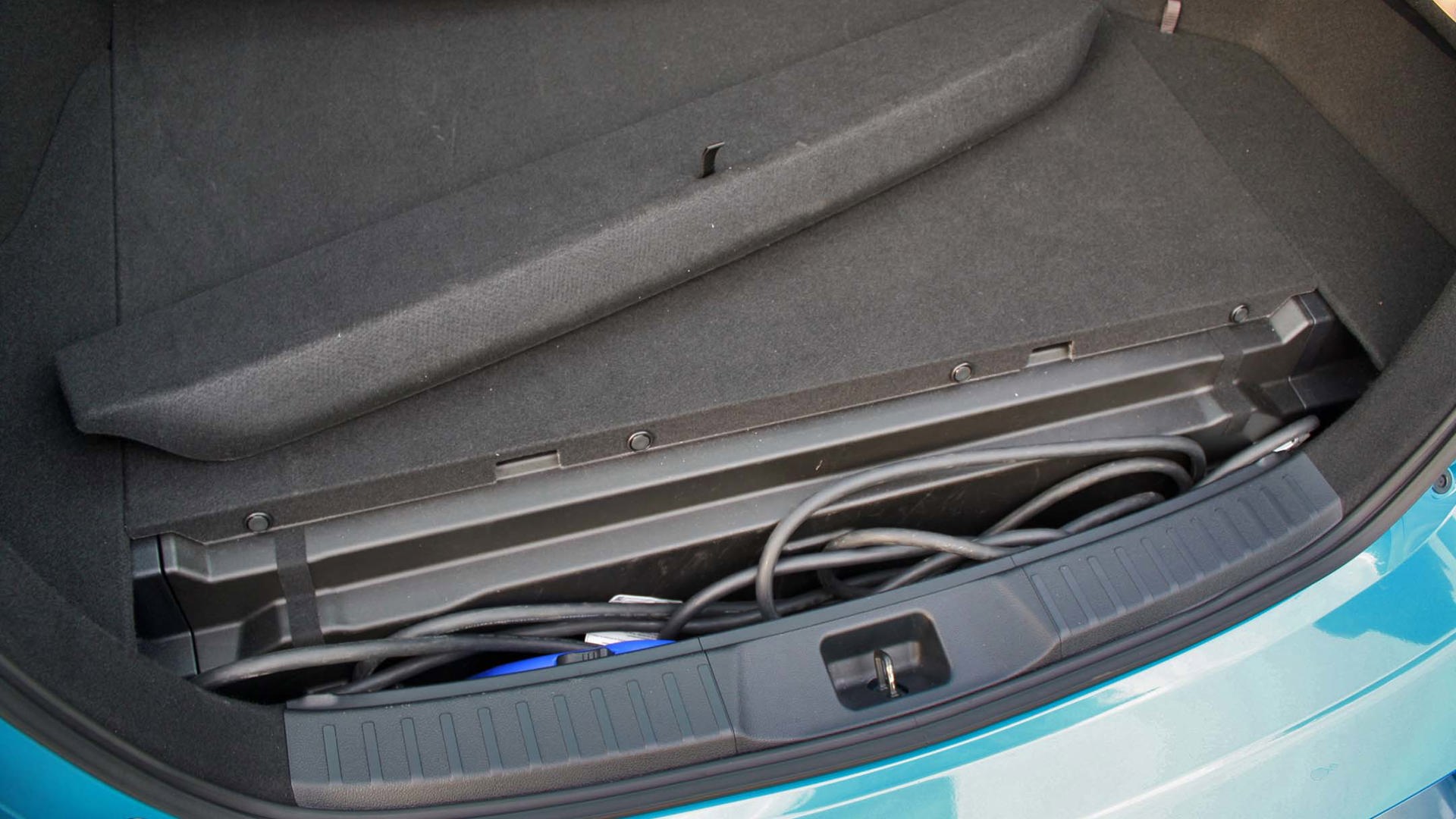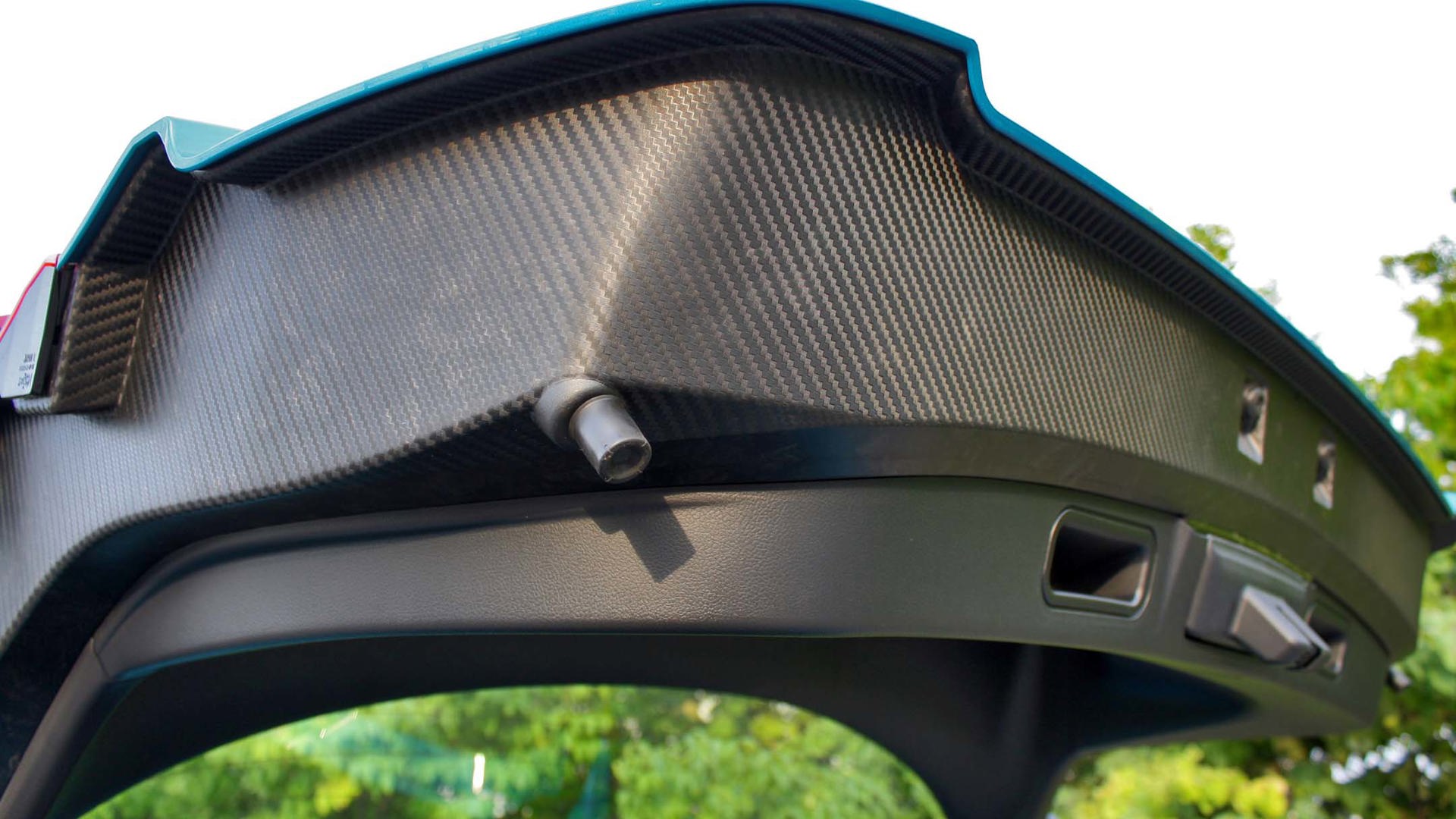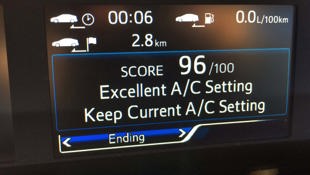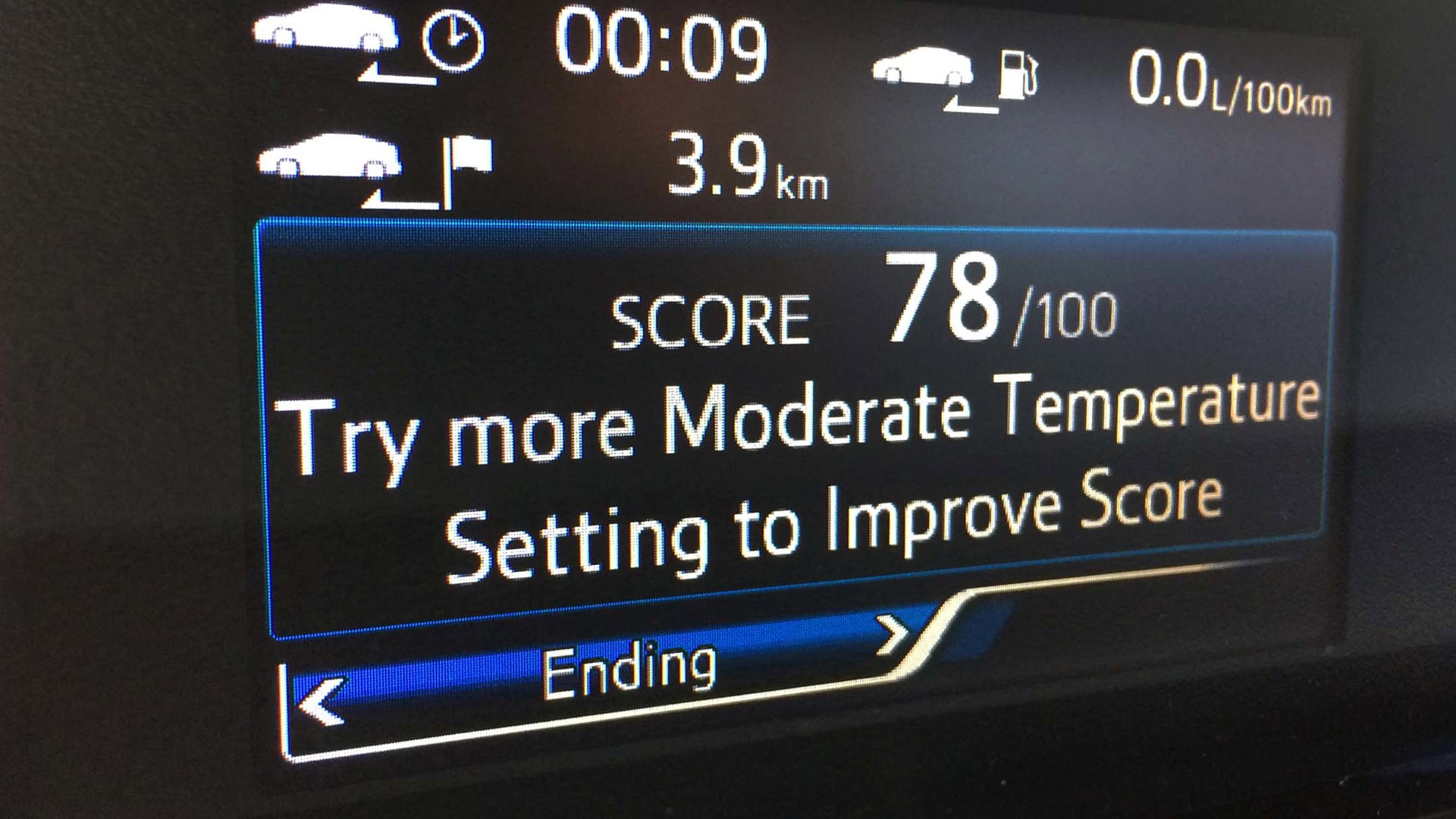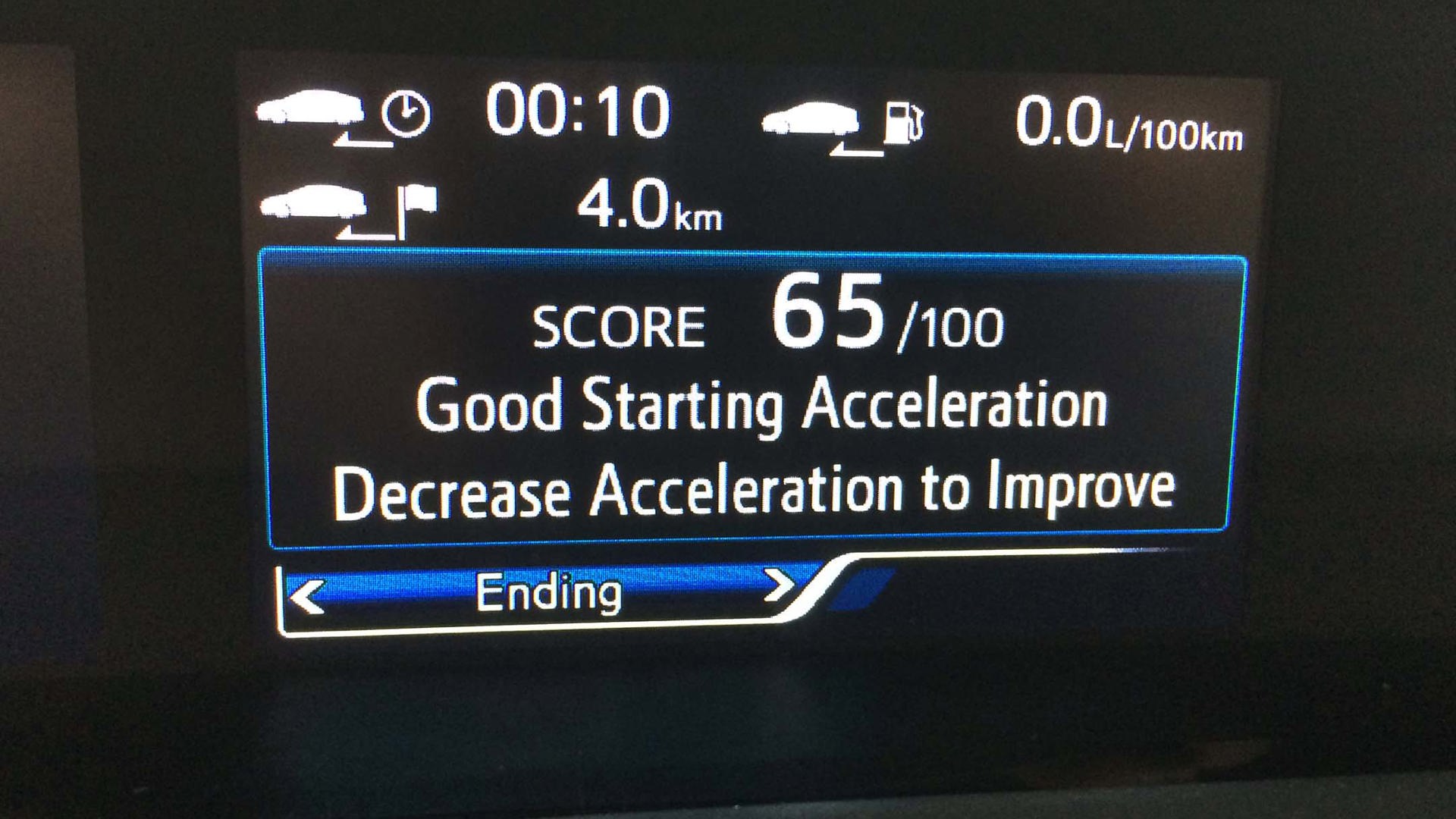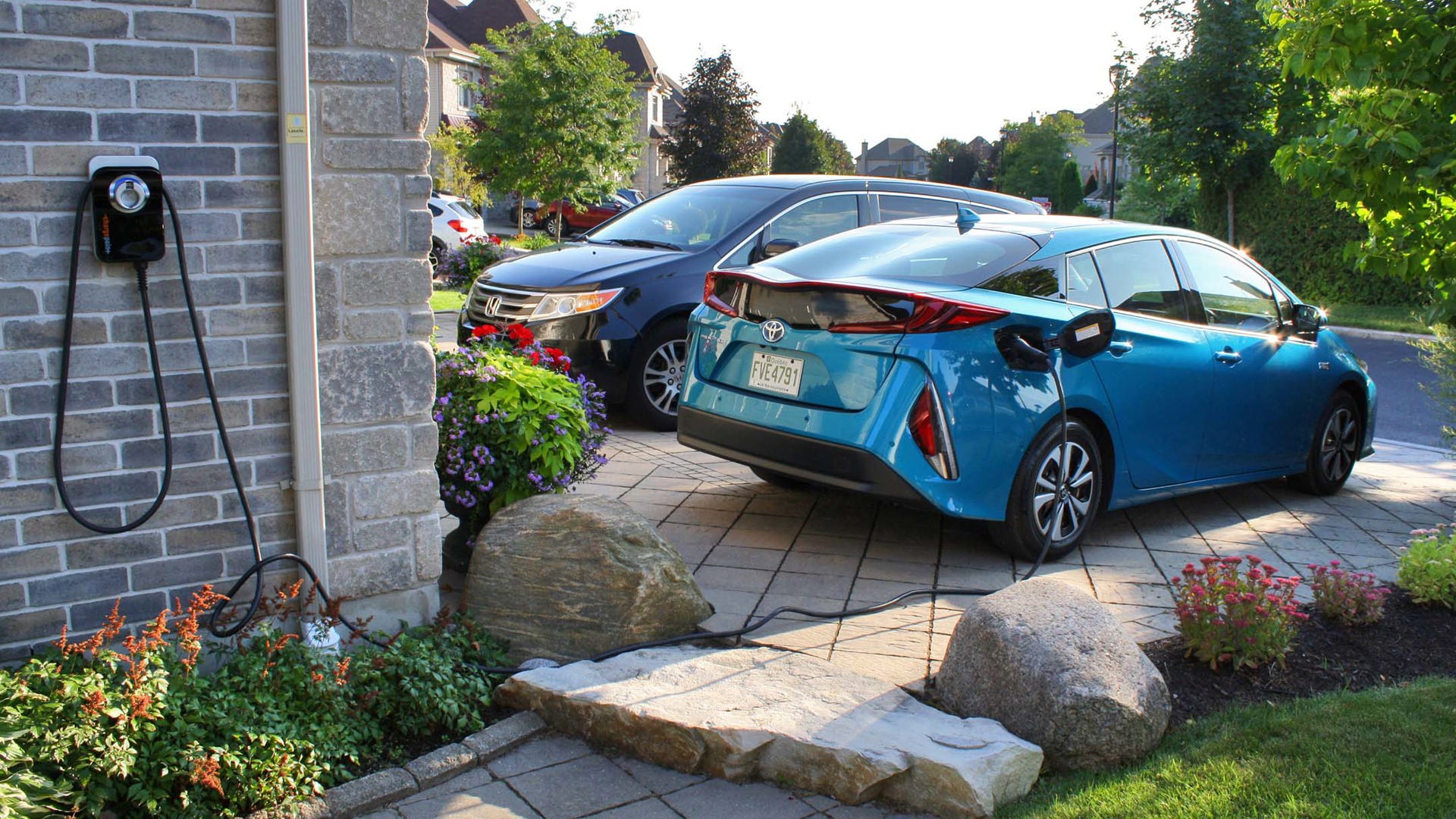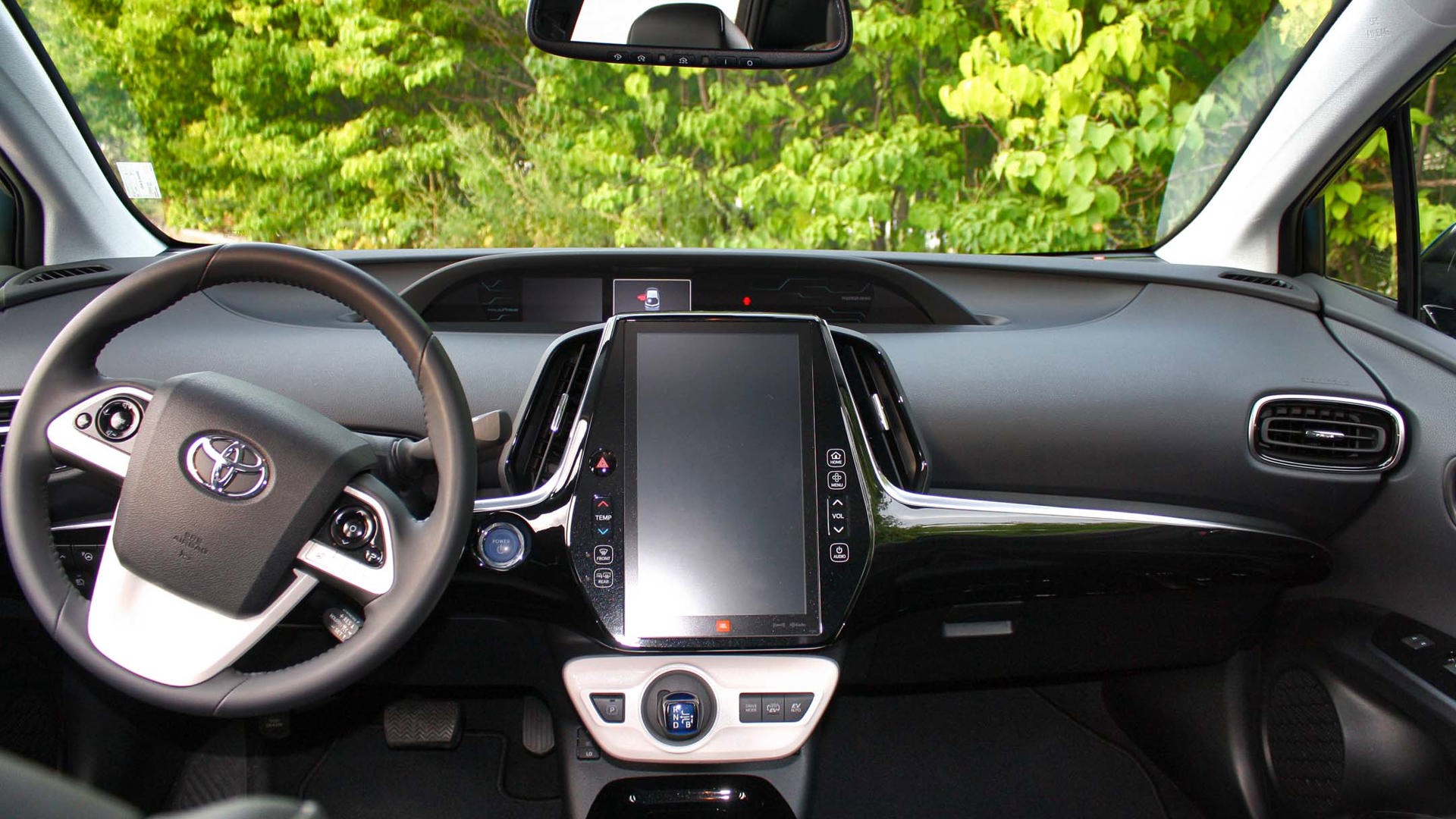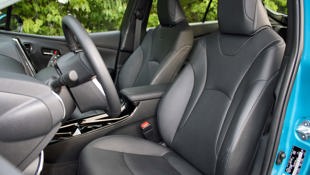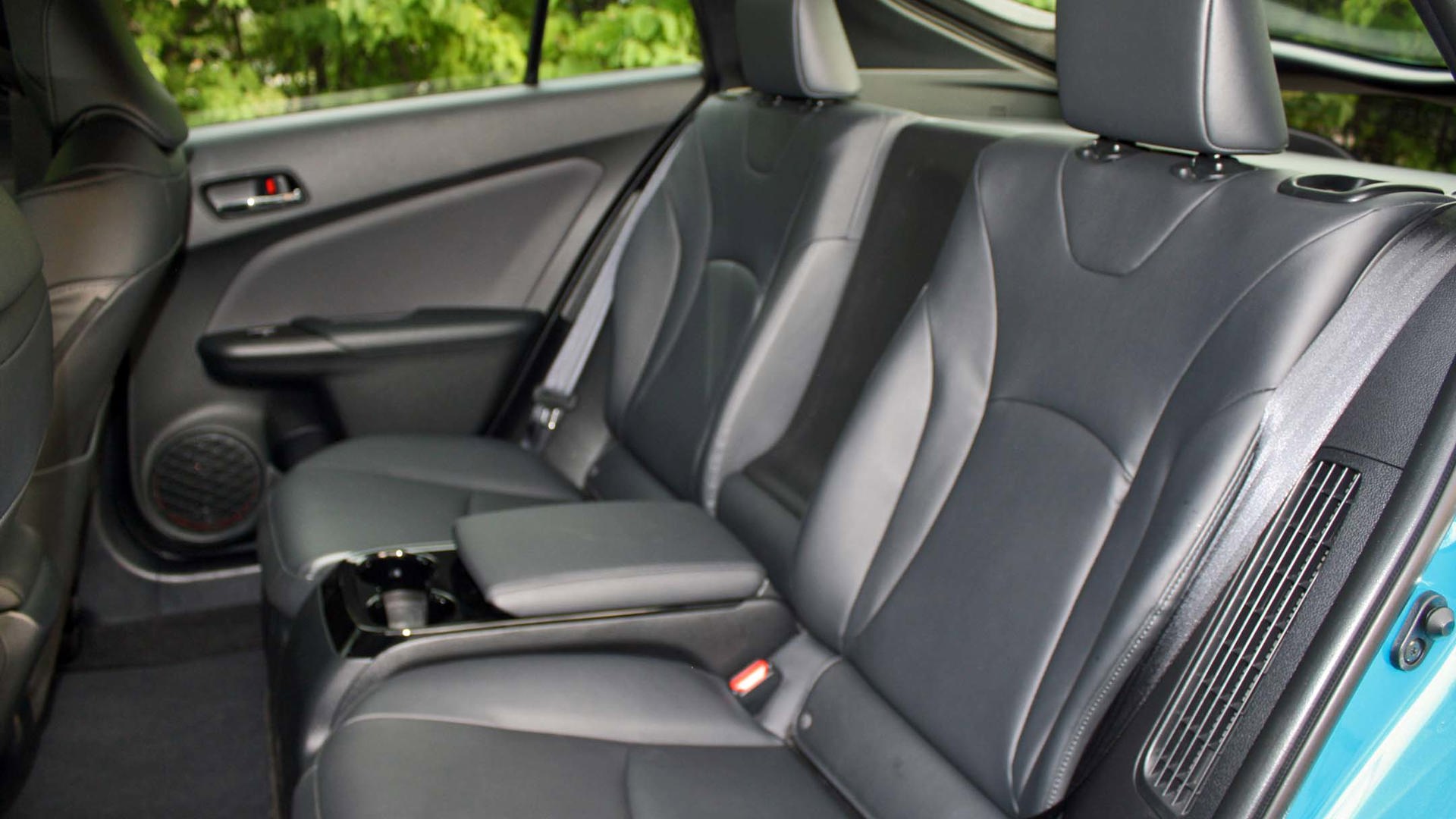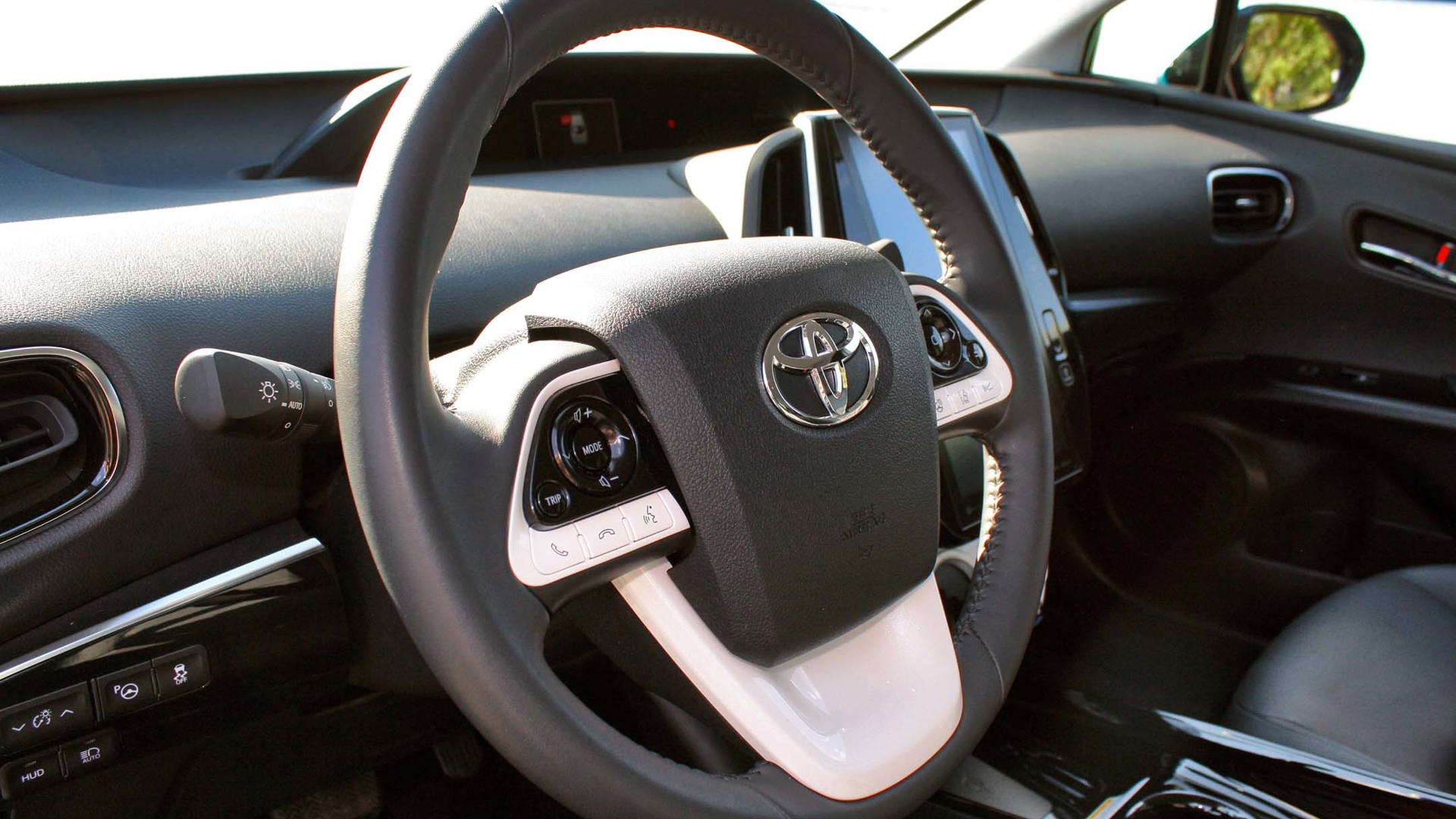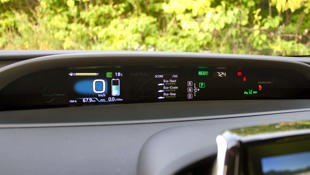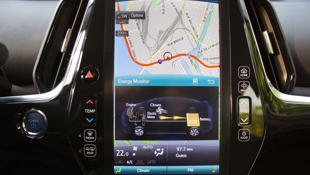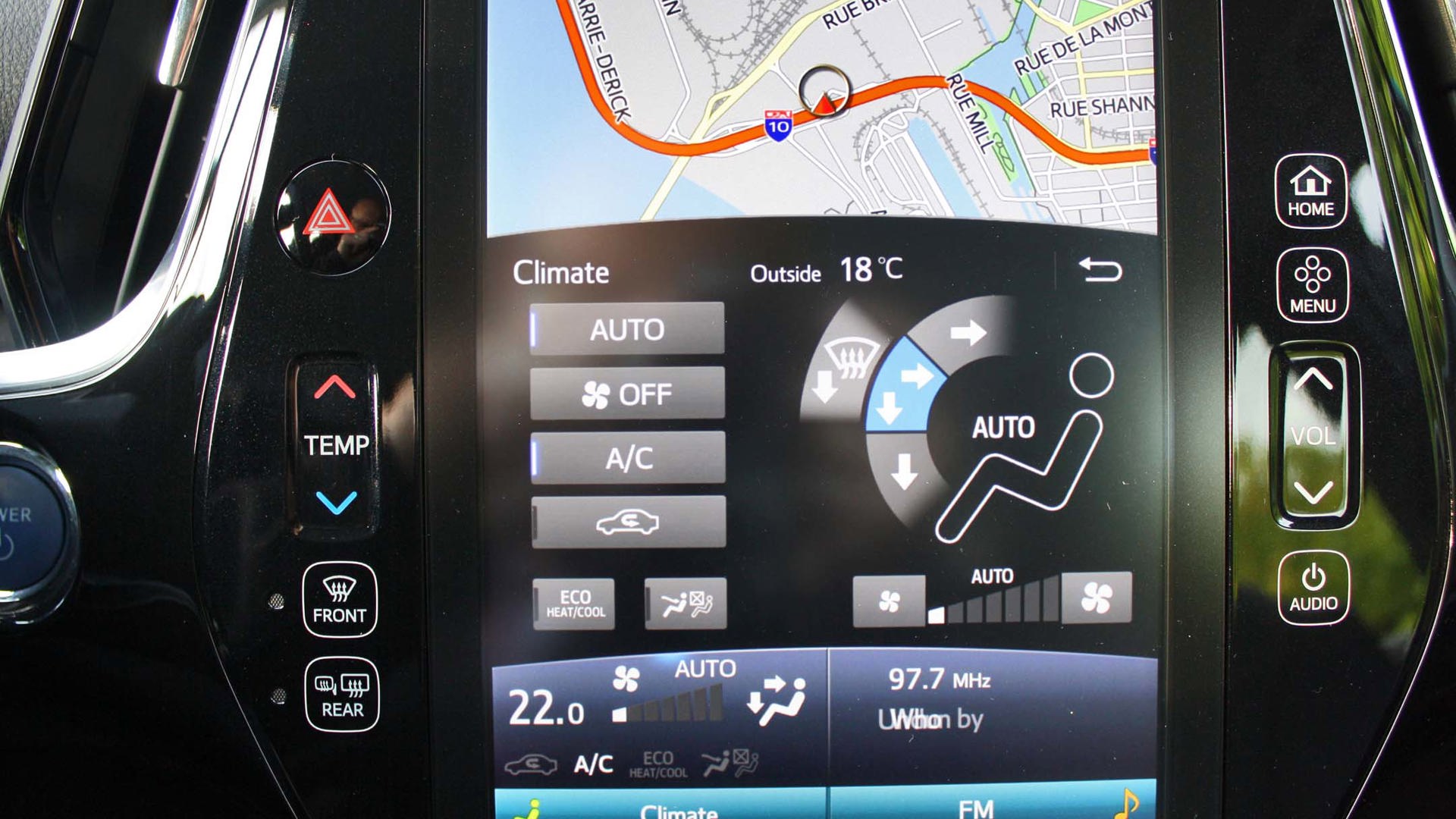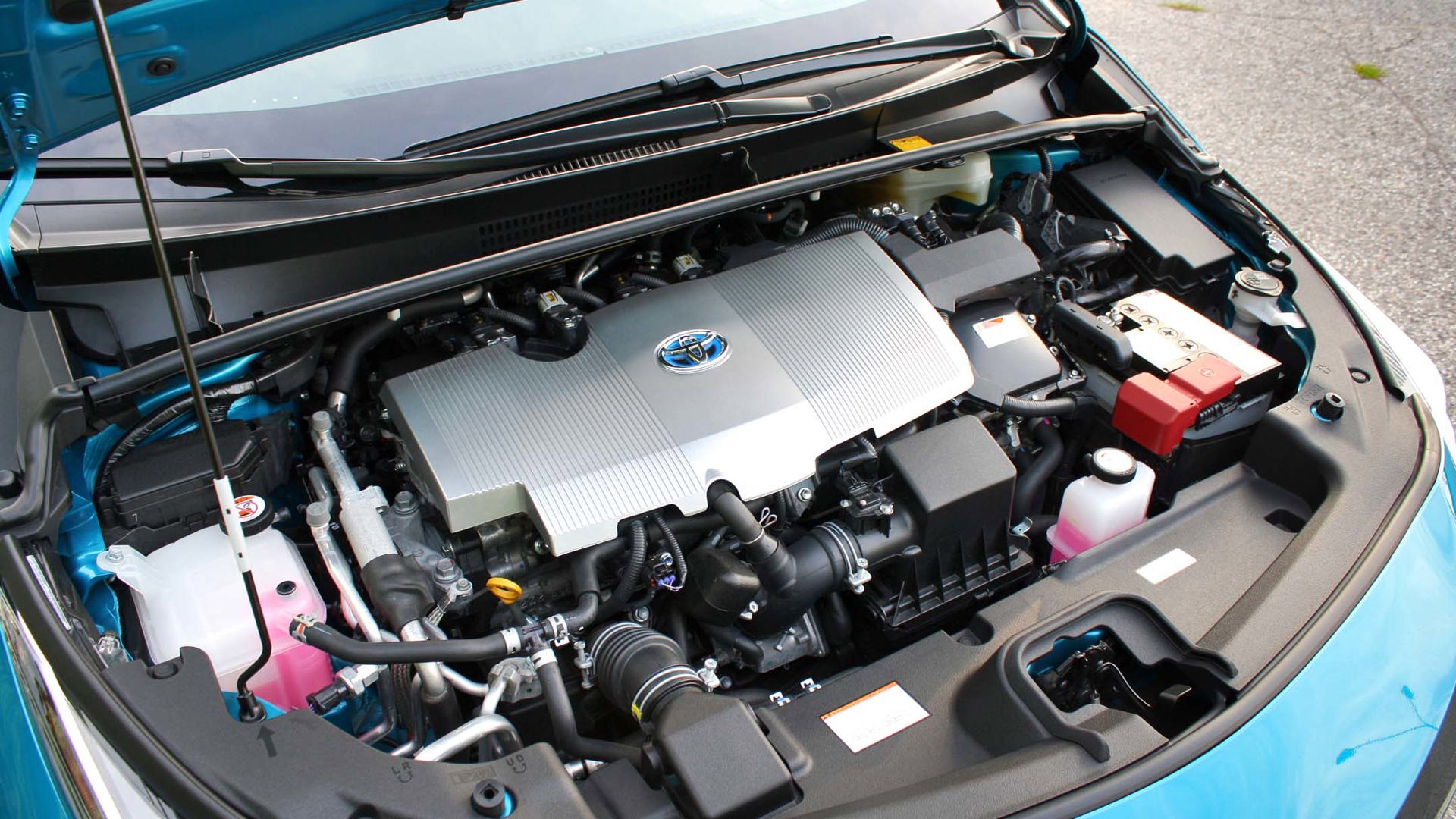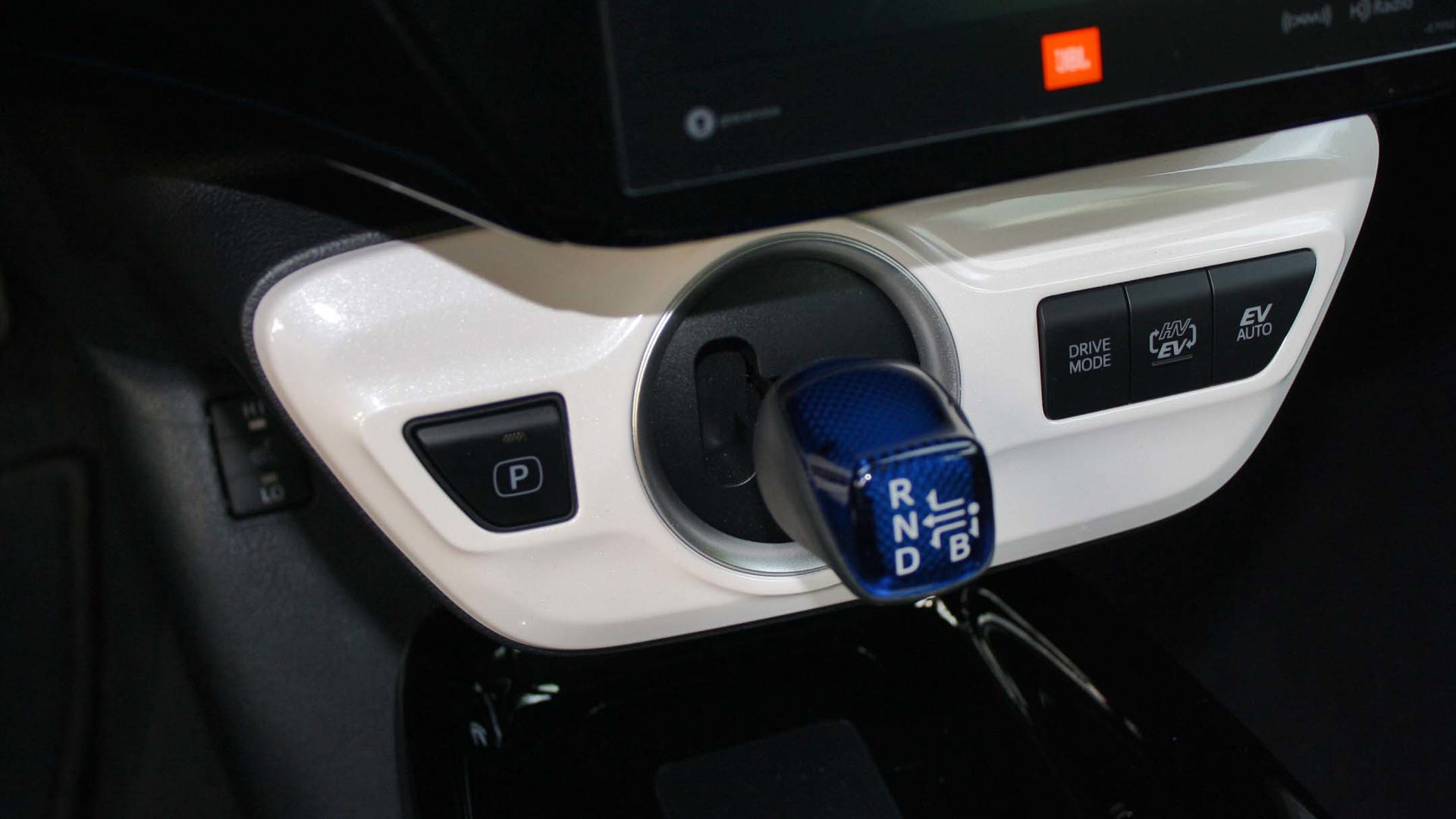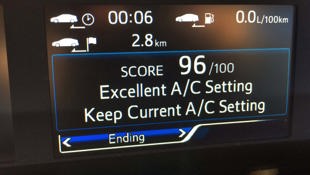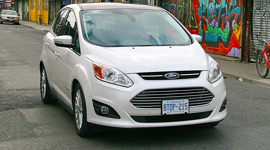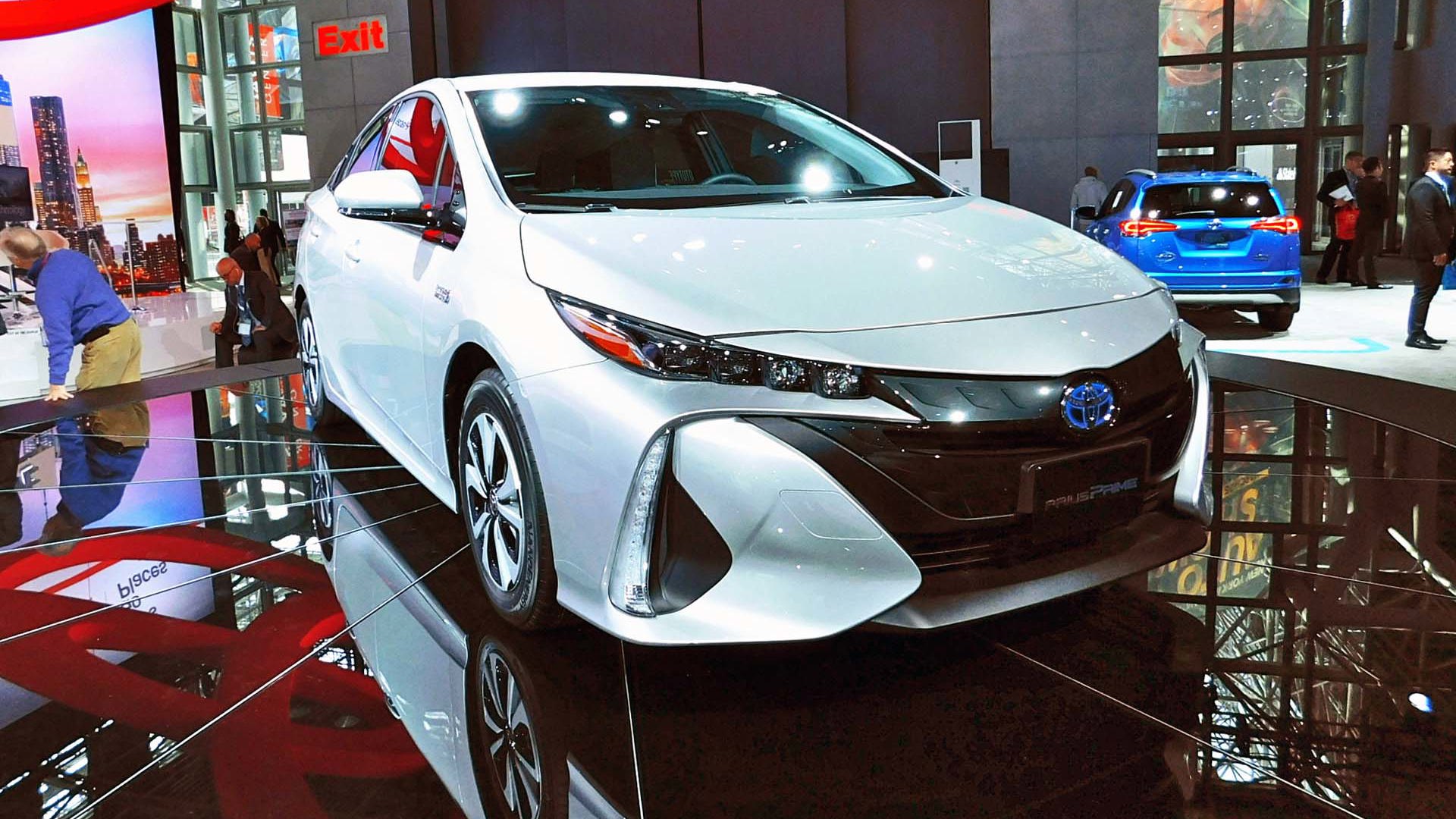 AutoTrader SCORE
AutoTrader SCORE
-
STYLING6/10
-
Safety8/10
-
PRACTICALITY6/10
-
USER-FRIENDLINESS4/10
-
FEATURES9/10
-
POWER8/10
-
COMFORT8/10
-
DRIVING FEEL7/10
-
FUEL ECONOMY10/10
-
VALUE8/10
The outlandish fourth-gen Prius doesn’t need to be explained anymore. We all know it’s riding on Toyota’s new TNGA modular platform, is even more frugal than its predecessor and looks like Marvin the Martian’s commuter pod. Perhaps to show the world (terrestrial or otherwise) how serious it is with this second attempt at a PHEV, Toyota wanted to make sure the plug-in 2017 Toyota Prius Prime would be easily noticeable.
Judging by all the rubbernecking that I left in my wake, whatever you call this polarizing design, it won’t be “beige”.
From the A-pillar forward, all bodywork is Prime-specific, including fenders, aluminum hood, headlights, bumper and grille (with active shutters). Out back, the Prime gets a carbon-fibre hatchback (saving 8 lb over the Prius’) inset with a concave, wavy, and just plain huge piece of unwipeable glass. The Prime’s entire rear cap is also exclusive, donning horizontal brake/tail lights and vertical white-to-amber turn signals. The designers finished things off by adding a specific set of aero plastic wheel covers and an exclusive Prime colour, the eye-popping Blue Magnetism, seen here on the test vehicle. Judging by all the rubbernecking that I left in my wake, whatever you call this polarizing design, it won’t be “beige” (even if painted Titanium Glow). The wind sure likes it – the Prime has a cd of 0.25.
Inside, the Prime loses the centre portion of the rear bench, the seat replaced by a combination armrest / storage console with cupholders. Based on the depth of the console, the four-seater config looks more targeted at giving the car premium flair than at providing extra space for the larger battery – expect a move à la Volkswagen CC down the road where the fifth seat reappears. The cockpit up front is largely shared with the regular Prius, except for the Prime Technology version’s exclusive use of a vertical 11.6-inch touchscreen.
But what puts the Prime at the very top of the Prius heap is its plug-in hardware. The lithium-ion battery offers a capacity of 8.8 kWh, 8.1 more than regular Prii. This juice box is hidden under the cargo floor, where it reduces cargo volume significantly (560 litres in the Prime vs 697 in the Prius behind the rear seats). Taking advantage of the Prius’ significant length (it’s a full 335 mm longer than a A3 e-tron), Toyota engineers used the gap between battery and bumper to create a deep, capped cubby to house the portable 120V charger. This unit is the lightest and most compact I have experienced so far in a plug-in, easy to hang from a garage outlet and requiring no bulky carrying case. The Prime’s SAE J1772 charging port, installed on the right rear fender, neatly mirrors the gas flap found on the left side of the car. The port is well-designed, lit by LED for plugging in the dark, and features a plug cover holder that seems to be a stand-in for an eventual fast charge port.
According to Toyota, a full charge on 120V takes five and a half hours, while on AC Level 2, such as at a typical 240V charging station, a fill-up only takes two hours and ten minutes. Using my ChargePoint home charging station and regular 120V plugs at the office, I matched both estimates from empty. Max range is estimated at 40 km by Toyota, and while a typical charge did net a projected 40.7 km on the display, I often bested that with up to 45.2 km after a full charge.
Left on the default EV mode, the Prime will leave its Atkinson-cycle internal combustion engine dormant as long as there’s juice in the battery, even at full throttle. Max speed in EV mode is 135 km/h, plenty for daily use. If these numbers ring a bell, it’s because they’re pretty much a carbon-copy of another PHEV’s, the aforementioned Audi A3 e-tron, whose battery has the same capacity.
At the helm
The Star Trek vibe is set to stun when you open the door. The panoramic windshield is stands far away from front passengers, bordered by thin A-pillars and corner windows for proper star gazing. The car’s slippery shape creates tons of headroom up front, enough for a six-foot tall engineer to sit there with his hard hat on and not rub against the headliner. As a result, the side windows are huge and offer more than enough light to wash out the massive touchscreen under all daylight conditions.
Set front and centre, the nearly-foot-tall Tesla-wannabe device is hard to ignore, and provides a cute animation of the car driving around Mother Earth upon start-up. On each side of it are touch-sensitive buttons for functions such as temperature and volume. Chevrolet had these trigger-happy buttons on the first Volt and left them out of the current car for a reason. It’s easy to overshoot temperature or volume adjustments when a single contact becomes multiple ones through bumps in the road. The audio on/off button has the same sensitivity but here the electronics behind it can’t follow, making it easy to think your command has been ignored.
On the display itself, the default view is navigation, and only the lower half of the screen is used by “apps” such as climate settings or audio. Its main fault is its location: front, centre, and flat – not angled towards the driver. It washes out so often in the daytime that it becomes effectively unusable at length, limiting access to some functions. Case in point: one of the tricks to extend range with a plug-in is to turn off the climate control when outdoor temps allow it. As such, most EVs offer a button to toggle the HVAC, but in the Prime one has to access the Climate menu on the screen and look for the “fan off” setting – a physical shortcut would have been appreciated.
And speaking of climate, designers apparently forgot us Canucks love to use our butt warmers. The buttons have been placed behind the centre console, and near the floor to add insult to injury – good luck using these on the go. Controls for driver’s aids are also set low to the left and can’t be safely used when driving.
The most logical array of controls in the Prime’s interior is found on the steering wheel. Here you’ll easily access phone and volume controls, and save yourself from touchscreen distractions. The trip computer is especially informative to use: on top of Trip A, Trip B, and odometer settings, it’ll also show additional info like total kilometres in EV mode. While the wheel itself is well-positioned and pleasant to grab, the wide glossy white plastic trim at the bottom feels cheap and made me think of Bugs Bunny’s front teeth – once you see them, you can’t unsee them.
Following Prius tradition is the little shifter wand-thing, jutting out of the white lower console and featuring, for some reason, a separate button for Park. Like in the current Volt, the shift lever’s knob is finished with an intricate blue motif. Unlike the Volt, the black surfaces that abound inside the car have a high-quality feel when you touch them, and you’ll even find some luxe in the detailing, like those chrome Prius-stamped handles for the vents.
The all-electronic instrument pod is located up high on the instrument panel where all passengers can see it. The driver gets a projected head-up display to save some neck-twisting while steering the craft. Using the HUD also allows the driver to ignore the clutter from the Eco Driving coaching and sensor feedback.
The Prime Technology sees its audio content upgraded to a 10-speaker JBL-branded kit, whose appreciation relies heavily on one’s musical preferences. Classic rock – or just plain rock – sounds as one-dimensional and flat as AM talk radio, with no midrange and no bass (and yes I tried different equalizer settings). Perhaps tied into the sci-fi surroundings, the JBL is completely transformed when fed electronic music – audio levels change, sound becomes crisp, music gains texture and synth bass will make the rear view mirror vibrate. Call it anti-analogue and load up your Deadmau5.
Passengers in the back get treated to great legroom, but the roof’s slope, while not as bad as the Volt’s, will preclude lifeforms taller than six feet from sitting there. All four seats in the tester were covered in SofTex, a synthetic material that screams “Plastic!” instead of “Leather!” and doesn’t breathe as well as it’s claimed to do, creating a back sauna under the sun. At least, Toyota got their shape right – all seats are very comfortable and supportive, with power adjustments up front.
The trunk provides a vast if shallow floor and comes with a roll-up cover to protect your supplies. The cover even drops at the end to keep the lower glass clear, but the bisected vision back there will make you want to keep the rear-view camera on at all times (which you can’t).
Take us out there
It’s time to take the Prime out of the shuttle bay and into the deep, black void. But it won’t budge. Now, amidst all the electronics surrounding us, where is the parking brake you think? In what must be a tribute to explorers of the Wild West, the Prime has a good-old spring-loaded parking brake pedal on the far left, an old-school item that made me smile.
Everything else is new school. Running in EV mode, the Prime offers a concerto of whirrs, buzzes, and clicks. Like all Prii, the electric motor emits a high-pitched whine that’s easily audible to everybody around when coasting to a stop; Audi’s e-tron is still the stealth champ. The driver gets to pick between “D” and “B” for forward motion, the latter promising more regeneration when coasting. Truth be told, the regen effect is so mild – no one-pedal driving, for instance –one might question why the standard “D” is there at all.
It takes a few clicks to get familiar with positioning the Prime. Seating is low and towards the middle of the car, and as a result it drives “bigger” than it is. With no need to see through it, the steering wheel is ideally placed, and offers a firm and precise helm on the pavement, an unexpected but pleasant surprise.
Picking what mode to drive in is an easy affair: Eco is dreadful in a busy town, slowing the go pedal’s actions to the point of becoming a liability. Power doesn’t feel any more powerful than Normal, which was just perfect for this abnormal car. Ignore the Eco Driving bar graph and the Prime will reward you with peppy competence. The only occasion where this Prius may reveal its beige past is when the pedal is floored – acceleration levels off, despite the additional pedal travel, as the car refuses to turn on the engine. But it more than keeps up with traffic as it does so.
The soft suspension is a strange bedmate to the firm steering and responsive traction motor, providing a comfortable ride over the broken riverbeds that line Montreal’s downtown core; at speed, the Prime becomes a bit too roly-poly, almost hinting at you to slow down. Brakes were more confidence-inspiring, the threshold between regen and friction braking apparent but not obtrusive.
Some of these impressions go out the window when the four-banger comes on. At steady speed on the highway, you may not even feel it coming on, and you’ll barely hear it. Prod what is now a throttle pedal and the engine will generate loud, unrefined econobox noises, complete with plenty of mooing from the CVT planetary gear set.
The Prime does have a trick up its sleeve to compensate: as shown by the battery level graph, it keeps a sufficient reserve to shut off the internal combustion engine (ICE) as much as possible and send it into a supporting role. Make that a cameo in my case. The Prime is incredibly efficient when running in EV mode, and it practices what it preaches: Indicated range is just that, indicated range, not an electoral promise. It will do what it says, as it did for me, no matter the conditions, surface streets or highways.
As with any plug-in, heating the cabin is the big battery-killer. On a 10-degree morning, indicated range dropped from 34 km to 24 km after turning on the HVAC system. The rear defroster will also put a dent in your range, and be ready to use it often in winter as the concave rear glass has no wiper.
Pennies per parsec
The Prime left me with the impression that Toyota will be a force to be reckoned with in the plug-in world. Running in EV mode, it is incredibly efficient, and this press car has spent 743 of its lifetime 8,773 km on electricity. I contributed a good chunk of that count, running 0.6 L/100 km over a 367 km tenure with the car, according to the onboard computer. Manually calculating from the 3.368 litres of gas I put in gives 0.9 L/100km, but with such a sipper the previous driver’s refilling location and technique are more to blame for the variation.
On the battery side of things, on average my ChargePoint app showed 6.08 kWh for a full charge, testament to the “reserve” in the 8.8 kWh battery for hybrid use. The Prime was considerably more efficient than my own e-tron, proving the dominant hybrid marque is now also poised to take the PHEV market. Sales are restricted to Quebec for now, and based on Prime sightings, many Quebecers did the post-incentive math – when going Prius, you might as well go Prime. Plus, in French-Canadian slang, “prime” means “quick”, which is a lot more positive than “étron” [Politely translated as “leavings”. –Ed.].
| Engine Displacement | 1.8L |
|---|---|
| Engine Cylinders | 4 |
| Peak Horsepower | 121 hp @ 5,200 rpm peak (95 hp gas; 71/31/91 hp electric main/secondary/combined) |
| Peak Torque | peak total N/A (105 lb-ft @ 3,600 rpm gas, 120/30 lb-ft main/secondary) |
| Fuel Economy | 4.3/4.4/4.3 L/100 km city/hwy/cmb; 1.8 Le/100 km |
| Cargo Space | 560 L |
| Model Tested | 2017 Toyota Prius Prime Technology |
| Base Price | $38,565 |
| A/C Tax | $100 |
| Destination Fee | $2,114 |
| Price as Tested | $40,779 before rebate |
|
Optional Equipment
None
|
|
